E RAE Electronics Industry Co EPM-4200 PDP Monitor User Manual 42
E-RAE Electronics Industry Co Ltd PDP Monitor 42
User Manual
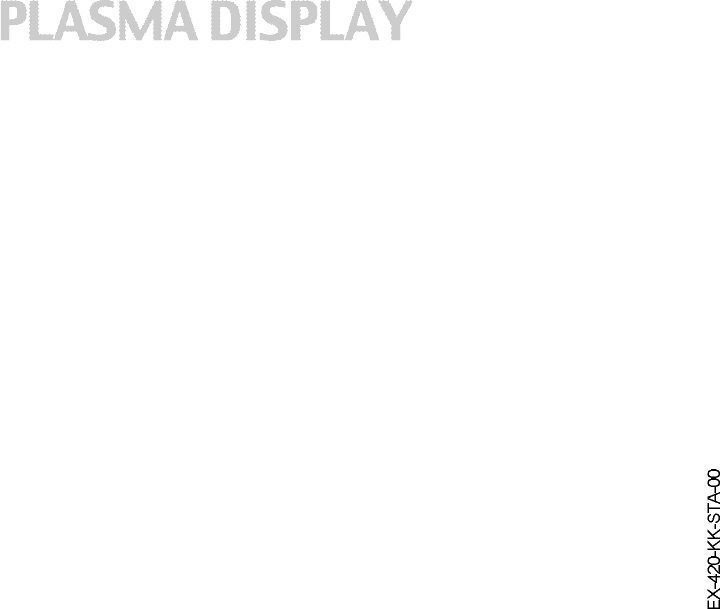
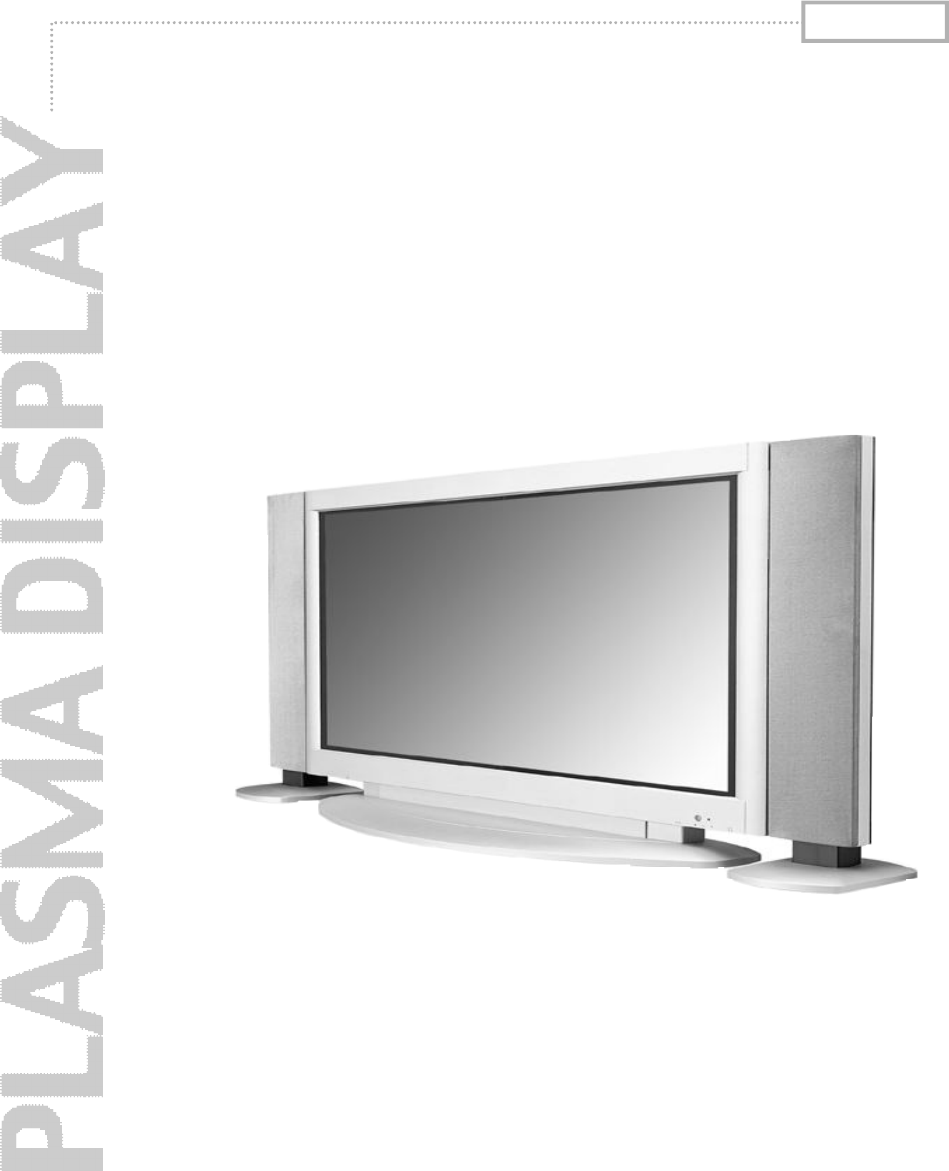
PDP
-
42
Man
ual
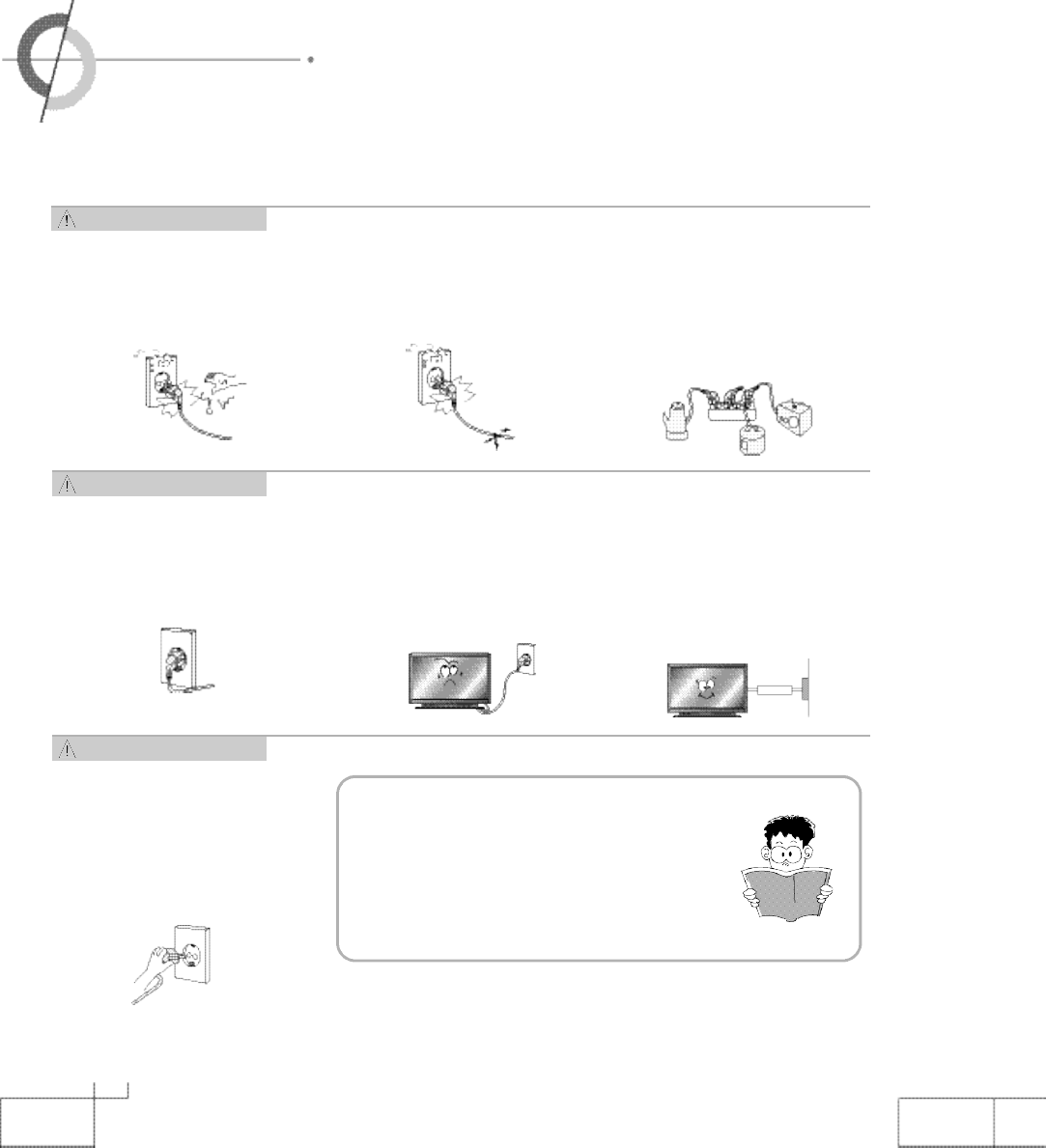
Power Supply
-
Caution
Power Supply
- Warning
Power Supply
- Warning
22
・Safety precautions
Do not use damaged electrical
cord/ plug, or loose outlet.
・It can cause an electric shock or a fire.
Do not use multiple devices in an
outlet at the same time to avoid the
overload.
・It may cause a fire due to overheating
from the outlet.
Fully insert the plug into the outlet.
・If the connection is unstable, it mayc a u s e
a fire.
AC plug should not be touched
with wet hands. It may cause an
electrical shock.
・It can cause an electrical shock.
Be sure to ground the PDP power
source.
・
It may cause an electrical shock if it has
a failure or electrical leakage. Only use
the proper power cord supplied with
PDP and connect it to an outlet with a
ground terminal.
Be careful not to forcibly bend the
electrical cords or press them with
a heavy object.
・It may cause an electrical shock or a
fire.
When unplugging the AC cord, pull
out by holding the plug itself and
not by pulling on the cord.
・If the power cord is damaged. it may cause
a fire.
This manual describes how to operate
the PDP properly and safely. Please
read this manual carefully.This manual
should be retained for future reference.
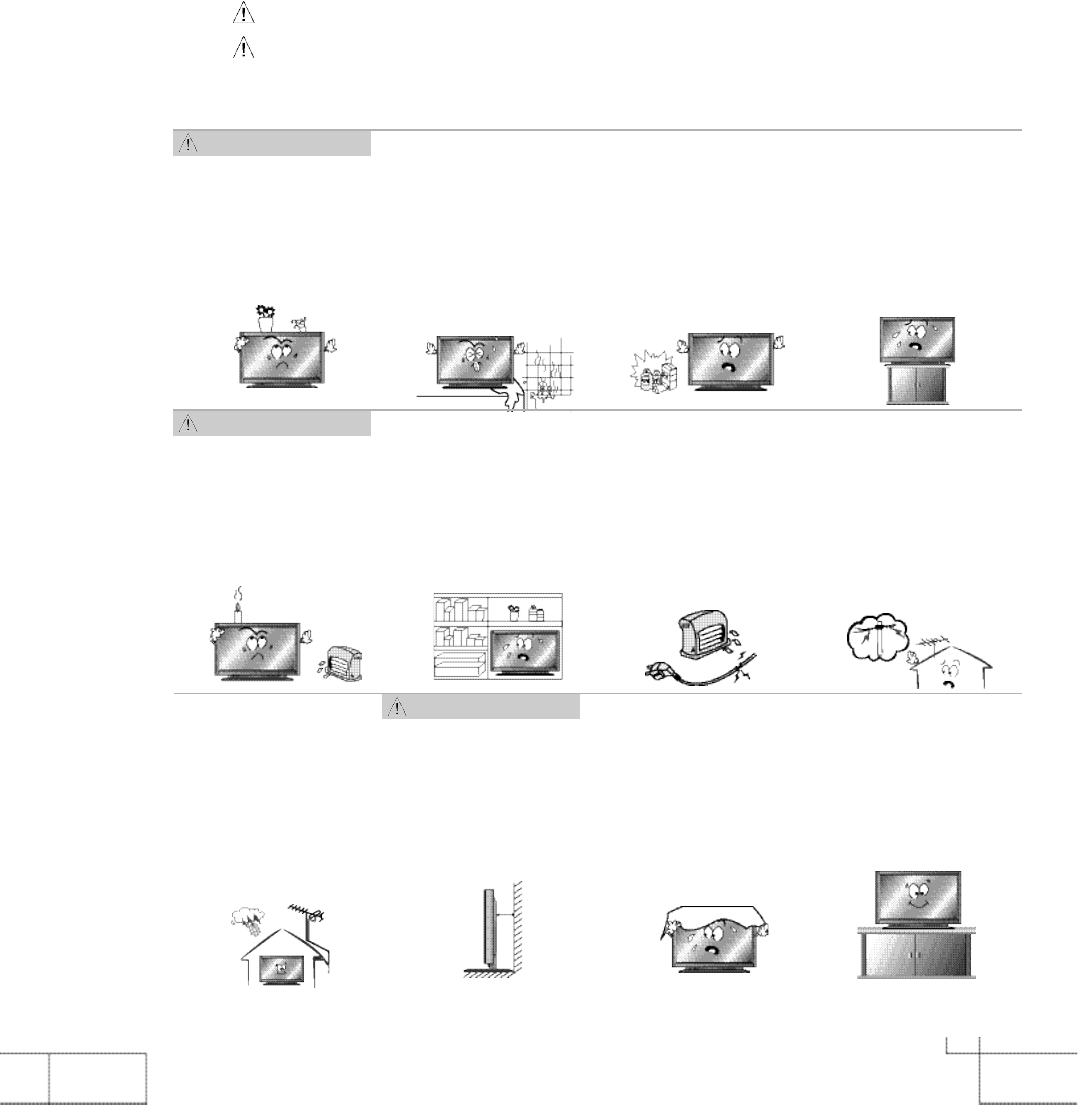
I n s t a l l a t i o n
-
Caution
I n s t a l l a t i o n
- Warning
I n s t a l l a t i o n
- Warning
33
Do not install the PDP whe
r
e
water (rain) drops can ente
r
the enclosure, or where
there is oil or humidity.
・
It may cause an electrical
shock, a fire, failure or trans-
formation.
Do not use or keep it in a
place where combustible
sprays or inflammable
materials are kept.
・
It may cause an explosion or
a fire.
Do not install in poorly
ventilated locations such
as bookcases or closets.
・
It may cause a fire due to
high temperature.
Do not place the electric
cord or the plug near an
electric heater.
・
The coating on the electrical
cords and the plug may melt
and cause a fire or an electri-
cal shock.
Install the antenna firmly
and away from high-volt-
age wires and communi-
cation cables.
・
If the antenna touches the
high-voltage wire, it may
cause an electrical shock or
a fire.
Do not put candles, mos-
quitoincense, cigarette
lighters, a heater, or any
other source of heat on or
near the PDP.
・
It may cause a fire.
The PDP should be
installed a small distance
away from walls or other
solid objects in order to
maintain ventilation and to
prevent heat damage.
Blockage of the ventilator
with table covers or cur-
tains can cause a fire due
to the increased tempera-
ture inside the monitor.
Be sure to install the mon-
itor on a level surface.
Make the antenna cable
loop at the entrance of the
building so that rainwater
will drop from the cable
before the cable goes into
the building.
・
If rainwater gets inside the
PDP, it may cause a fire or
an electrical shock.
W a r n i ng : Serious injury or fatal injury may occur, if the indicated warning is not followed.
C a u t i o n : Minor injury or product damage may occur, if the indicated caution is not followed.
Do not place any liquid and
foreign objects on or above
the PDP.
・It may cause an electrical
shock and a fire. Contact your
dealer for service.
Do not install the PDP in an
unstable location with a
smaller support area than
the PDP. It may fall and
cause injury.
・
It should be installed on a flat,
stable location.
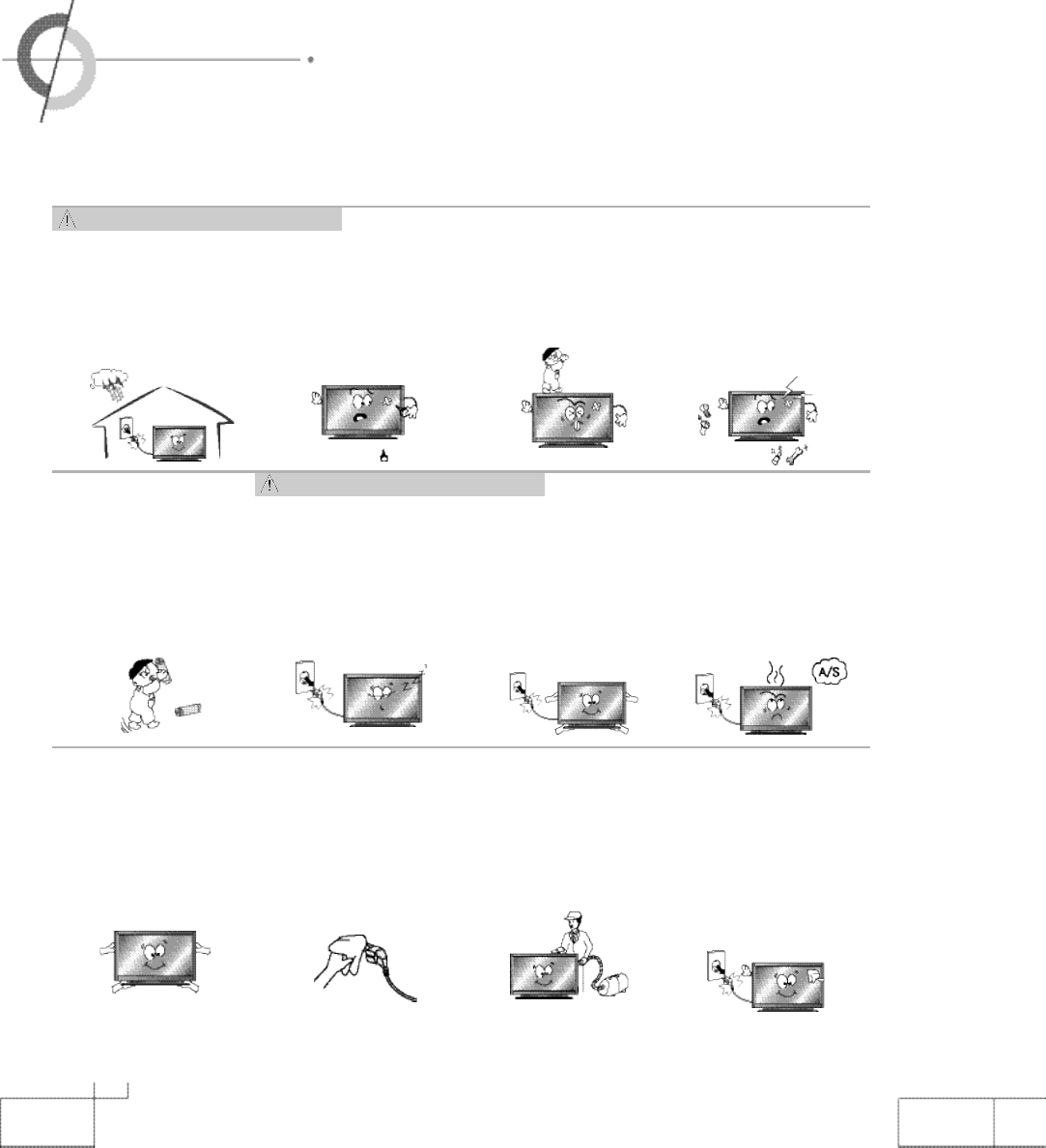
Usage and Maintenance -
Caution
Usage and Maintenance -
W a r n i n g
4
・Safety precautions
Do not insert any foreign
objects such as wires and
drills into the PDP ventilation
slots or the A/V terminal.
・It may cause an electrical
shock or a fire.
Do not allow children to
play with the PDP.
・
It may falls or flip over and
may cause serious injury.
Never attempt to disas-
semble, repair or modify
the PDP.
・It may cause an electrical
shock or a fire. If it requires
repair, contact your dealer.
During a thunderstorm,
unplug the power cord
and never touch the
antenna cable.
・It can cause an electrical
shock or a fire.
Unplug the PDP if you do
not intend to use it for a
long time. The generation
of heat, insulation degrada-
tion or the accumulation of
dust may cause an electri-
cal fire.
When removing the batter-
ies in the remote control,
please place the batteries
in a location out of chil-
dren's reach . It must be
disposed properly.
The plugs and connectors
must be free of dust or
water before use. It may
cause an electrical shock
or a fire.
When transporting the PDP,
at least two people should
carry it. If it is dropped, seri-
ous injury may occur.
To clean the interior of the
PDP, contact your dealer for
service. A fire or failure may
occur, if it is not cleaned.
When moving the PDP, turn off
the power switch and unplug the
power cord from the outlet. Make
sure that the external connection
cords are unplugged (such as
antenna cable and input cables)
prior to moving.
・
The electrical cords may get
damaged and cause an electrical
shock or a fire.
When cleaning the PDP,
unplug the electrical cord
and wipe
w
i
th a soft and
dry cloth. Never clean with
chemicals such as industri-
al glaze, wax, benzene,
alcohol, thinner, aromatic,
lubricant, detergent, or a
damp cloth.
If the PDP is emitting smoke
or an unusua
l
smell,
i
mmedi-
ately turn off the power and
unplug the power
c
ord.
・
It may cause an electrical
shock or a fire. Contact your
dealer for the service.
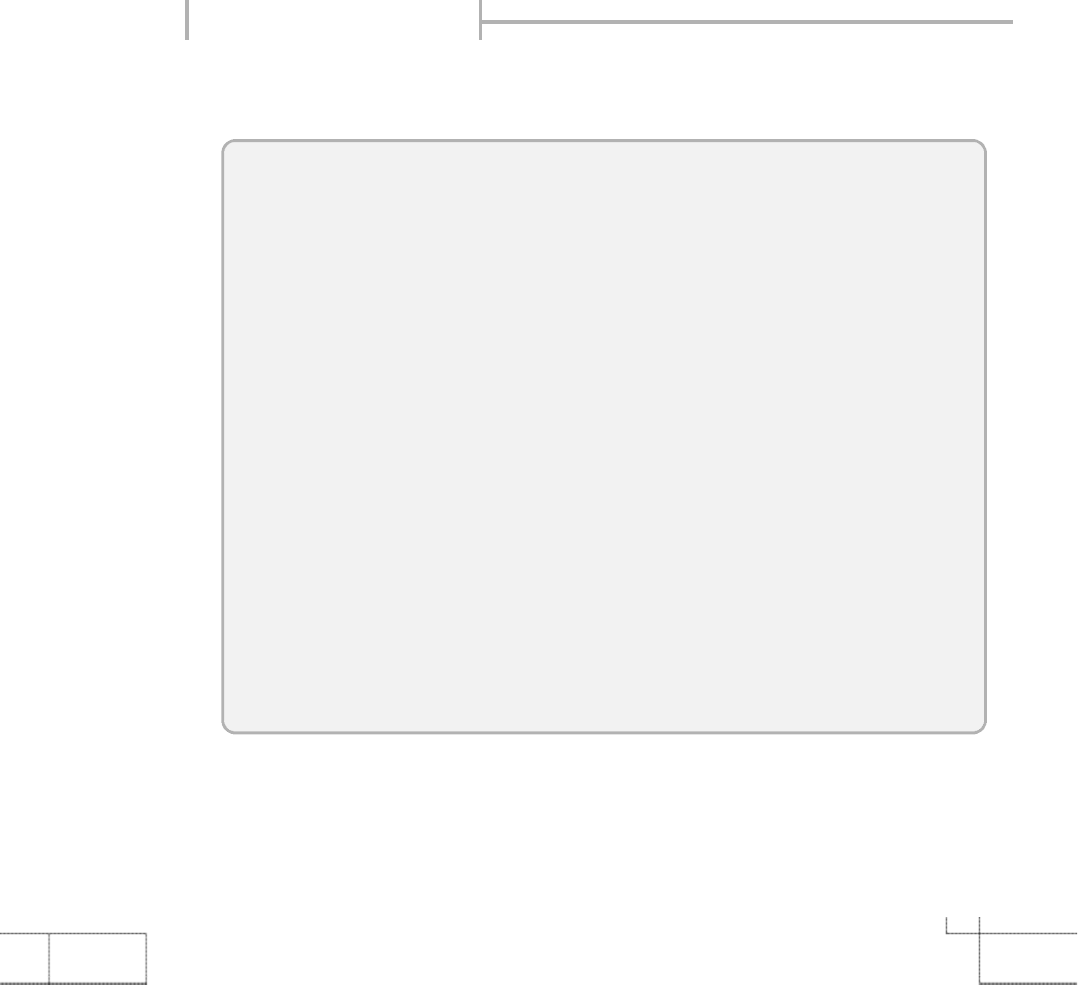
5
Considerations for Usage
Still image (immovable) screen may cause permanent damage to PDP.
1.
Lengthy display of still images from video games, banners, graphics and others may fatally
damage the screen.
2.
When using Picture-In-Picture, permanent damage may occur if the sub-image screen stays
on the corner of screen for a long time.
3. When using the PDP in 4:3 formats with sidebars for a long period of time, it may cause dam-
age to the plasma panel. It is recommended that you use 16 :9 or Panorama format. (Image
burn-in can be avoided by using "White Wiper" function or a screen-saver. However, once
image burn-in occurs, it may not disappear completely. An image will be dimmed as the
image is displayed long time or repeatedly.)
※
Any damage to the PDP caused by improper usage (such as image burn-in) shall not be cov
-
ered by the warranty.
Defective pixels that can be seen on PDP screen. (illuminated spots, bright spots,
scotoma , blind spot, blinking)
Generally, PDP consists of about 1.22 million pixels and the possibility of having defective pixels
is quite high. A PDP with a number of defective pixels below a certain number is not considered
defective. The limited number of defective pixels does not affect the performance or reliability of
the PDP. The standard of inspection regarding defective pixels is the same or better as the com
-
petitor's offering on similar PDP. It is not subject to replacement or a refund. We will do our best
to minimize the defective pixel as best as we can.

6
・Contents
・
Safety precautions
-
Power Supply
……………………………………………………………… 2
-
Installation
…………………………………………………………………3
-
Usage and Maintenance
…………………………………………………4
・
Considerations for Usage
………………………………………………… 5
・
Contents
………………………………………………………………… 6 ~ 7
User Guidance Information
・
Names of each part
…………………………………………………… 8 ~ 9
・
Options
…………………………………………………………………… 1 0
・
Accessories
…………………………………………………………………1 1
・
Installing the PDP
-
Installing on a wall
……………………………………………………… 1 2
-
Installing on a desktop
………………………………………………… 1 3
・
Remote controller
-
Functions of remote control buttons
………………………………… 1 4
-
Inserting batteries into remote control
……………………………… 1 5
Connection
・
Connecting to the VCR
………………………………………………… 1 6
・
Connecting to the Cable TV
…………………………………………… 1 7
・
Connecting to the Camcorder/ Video game console
……………… 1 8
・
Connecting to the DVD player
………………………………………… 1 9
・
Connecting to the DTV receiver
………………………………… 20 ~ 21
・
Connecting to the PC
……………………………………………… 22 ~ 23
Basic Use
・
Powering the PDP
……………………………………………………… 2 4
・
Selecting input source
…………………………………………………… 2 5
・
Volume
……………………………………………………………………… 2 6
・
Mute
………………………………………………………………………… 2 6
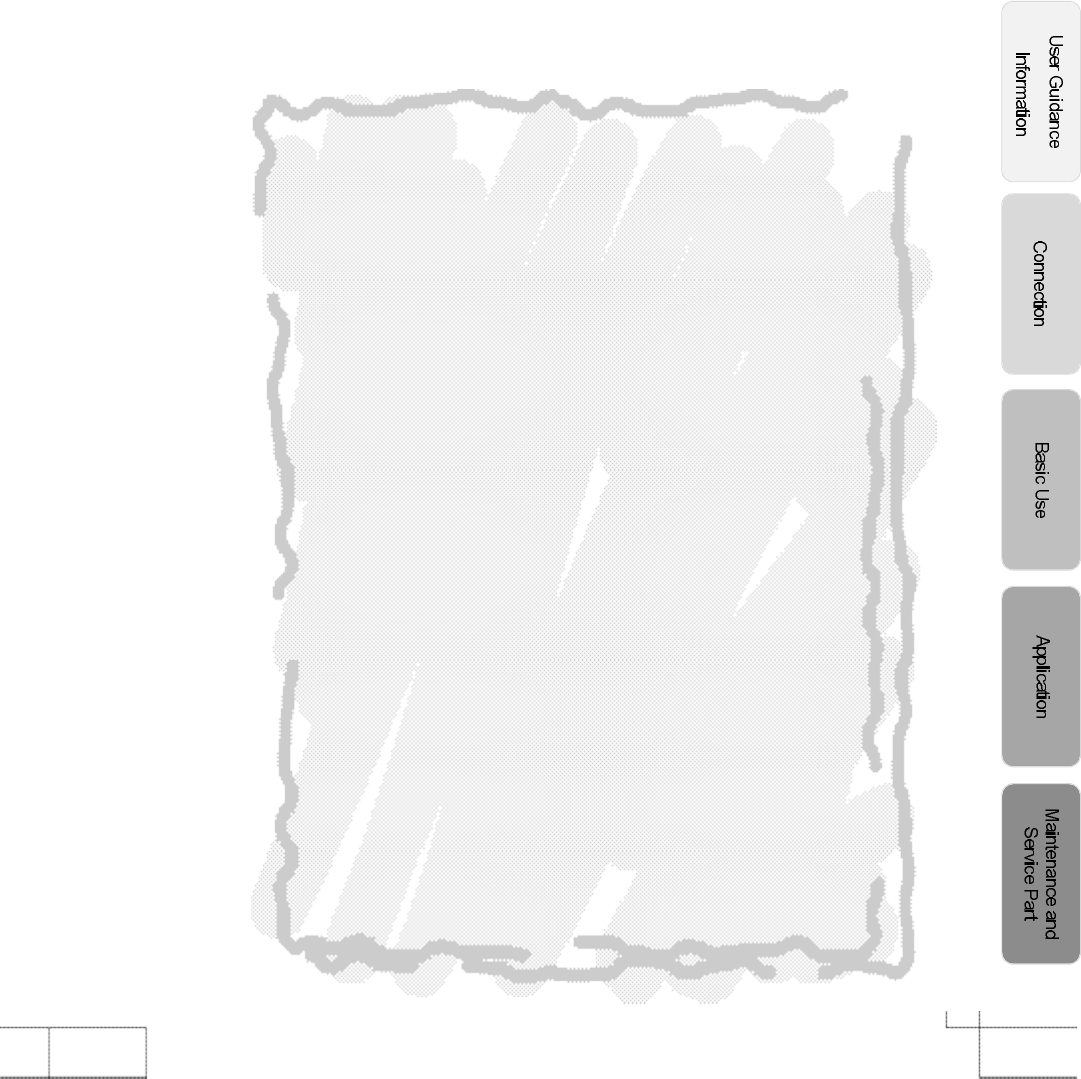
7
・
Still
………………………………………………………………………… 2 6
・
Info
………………………………………………………………………… 2 6
・
Menu
……………………………………………………………………… 2 7
Application
・
PSM (Picture Status Memory)
………………………………………… 2 8
・
Adjusting the screen in USER mode
………………………………… 2 9
・
ARC (Aspect Ratio Control)
…………………………………………… 3 0
・
Watching PIP
……………………………………………………………… 3 1
・
PC mode
……………………………………………………………… 32 ~ 33
・
Color Tone (Pre-Set)
…………………………………………………… 3 4
・
Color Tone (Manual adjustment)
……………………………………… 3 5
・
SSM (Sound Status Memory)
………………………………………… 3 6
・
Equalizer
…………………………………………………………………… 3 7
・
Stereo
……………………………………………………………………… 3 8
・
Reset
……………………………………………………………………… 3 9
・
Language
………………………………………………………………… 4 0
・
Half Tone
…………………………………………………………………… 4 1
・
Panel Protection
………………………………………………………… 4 2
・
PBP Mode
………………………………………………………………… 4 3
・
Current Time setting
……………………………………………………… 4 4
・
On Time/ Off Time (Time setting)
……………………………………… 4 5
・
On Time Volume
………………………………………………………… 4 6
・
Sleep Timer
……………………………………………………………… 4 7
Maintenance and Service Part
・
Trouble shooting
…………………………………………………… 48 ~ 50
・
Supporting display mode
………………………………………………… 5 1
・
Specifications
……………………………………………………………… 5 2
・
User Information
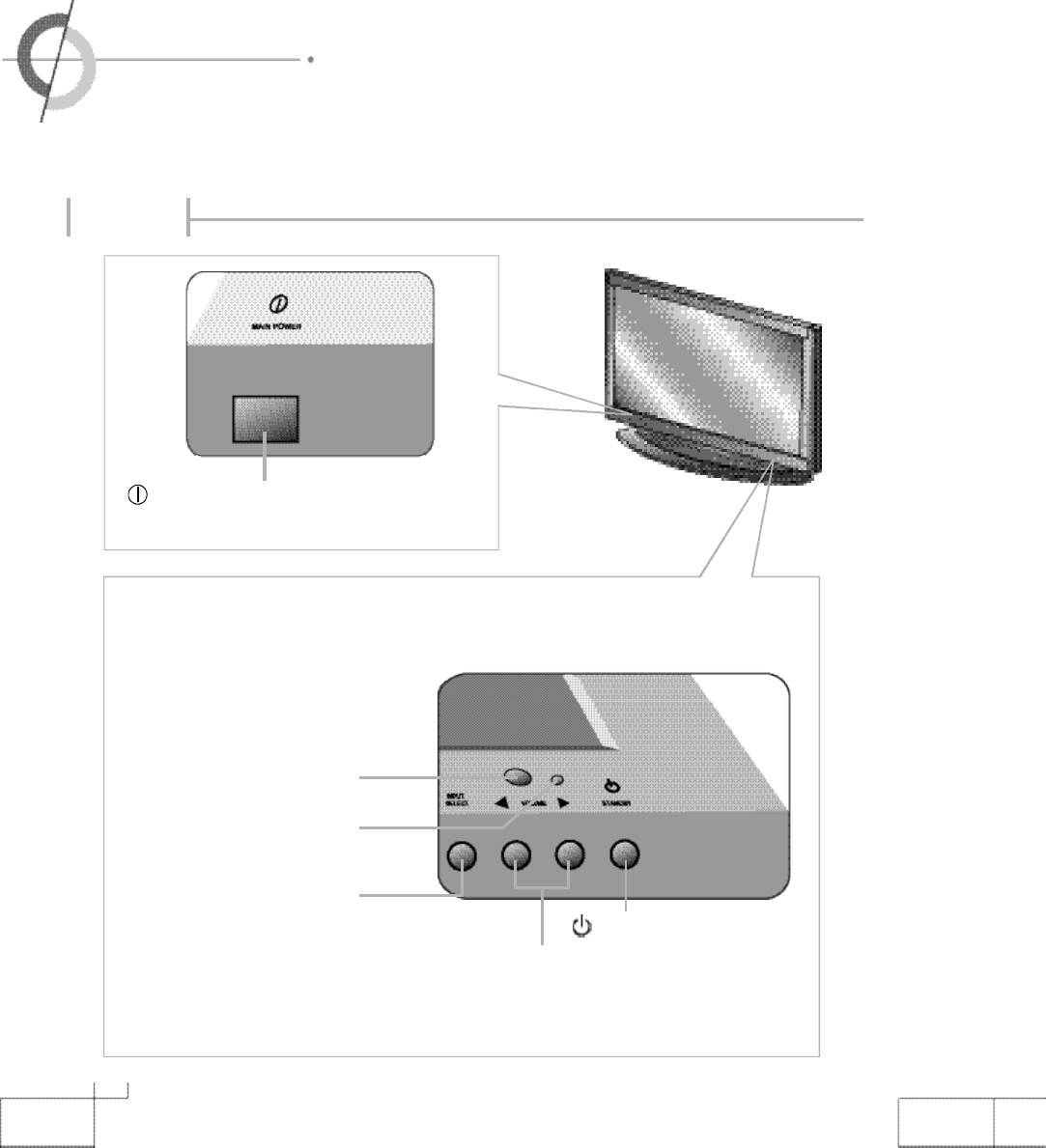
8
・Names of each part
Front View
Remote Control Receiving Sensor
Power Supply Indication Lamp
Standby : Red
On : Green
Input Selection Button
Main Power Button
-
Please turn off the main power switch, if the PDP will not be
used for a long period of time.
Volume ◀
,
▶ B u t t o n
Standby
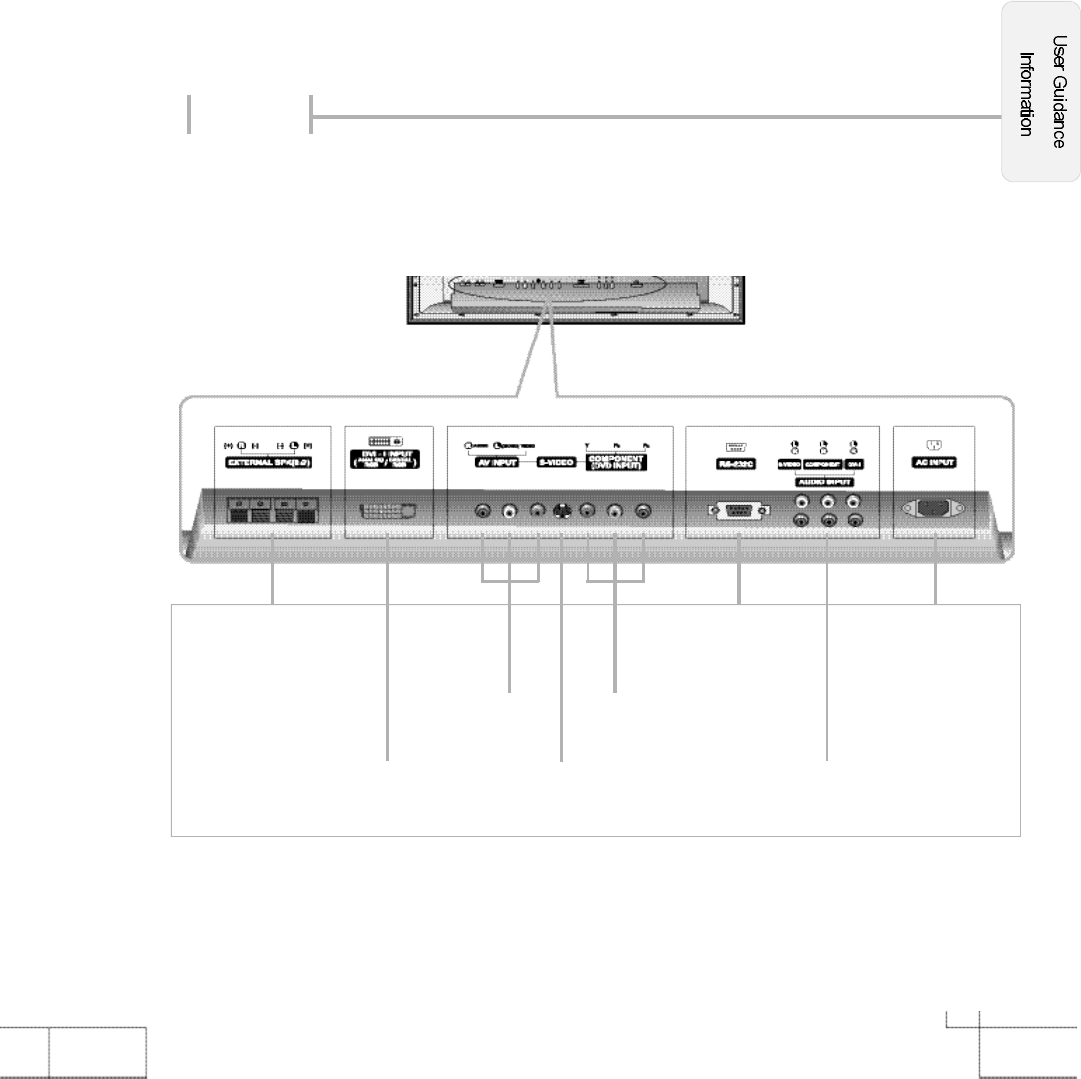
9
Back View
RS-232C TerminalExternal Speaker Connection
Terminal (8Ω)
RGB PC Input Terminal
(VGA / SVGA / XGA) S-Video Terminal
Component (DVD / DTV)
Input Terminal
(480i /480p / 720p/ 1080i)
AV input (composite)
Terminal
Audio Input Terminal
(S-Video, Component, DVI)
AC Input Terminal
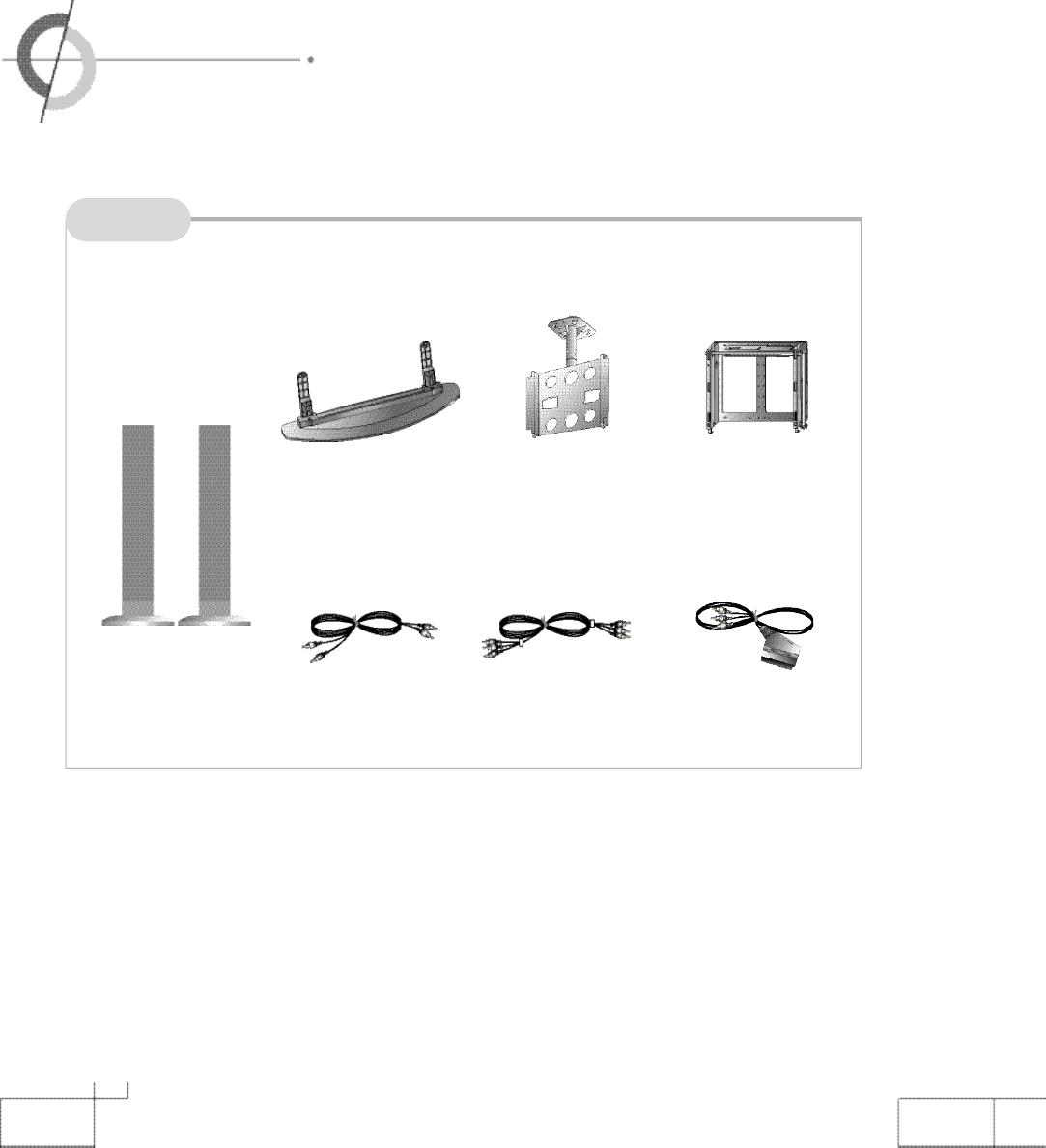
1 0
・Options
Options
※
To improve the quality of the PDP, specification is subject to change without notice. Please
contact your dealer for current options available.
Adjustable - Angle
Wall mount
Ceiling - M o u n t
B r a c k e t
Desktop Stand
S p e a k e r Video Cable
Scart
-
RCA
C a b l e
Audio Cable
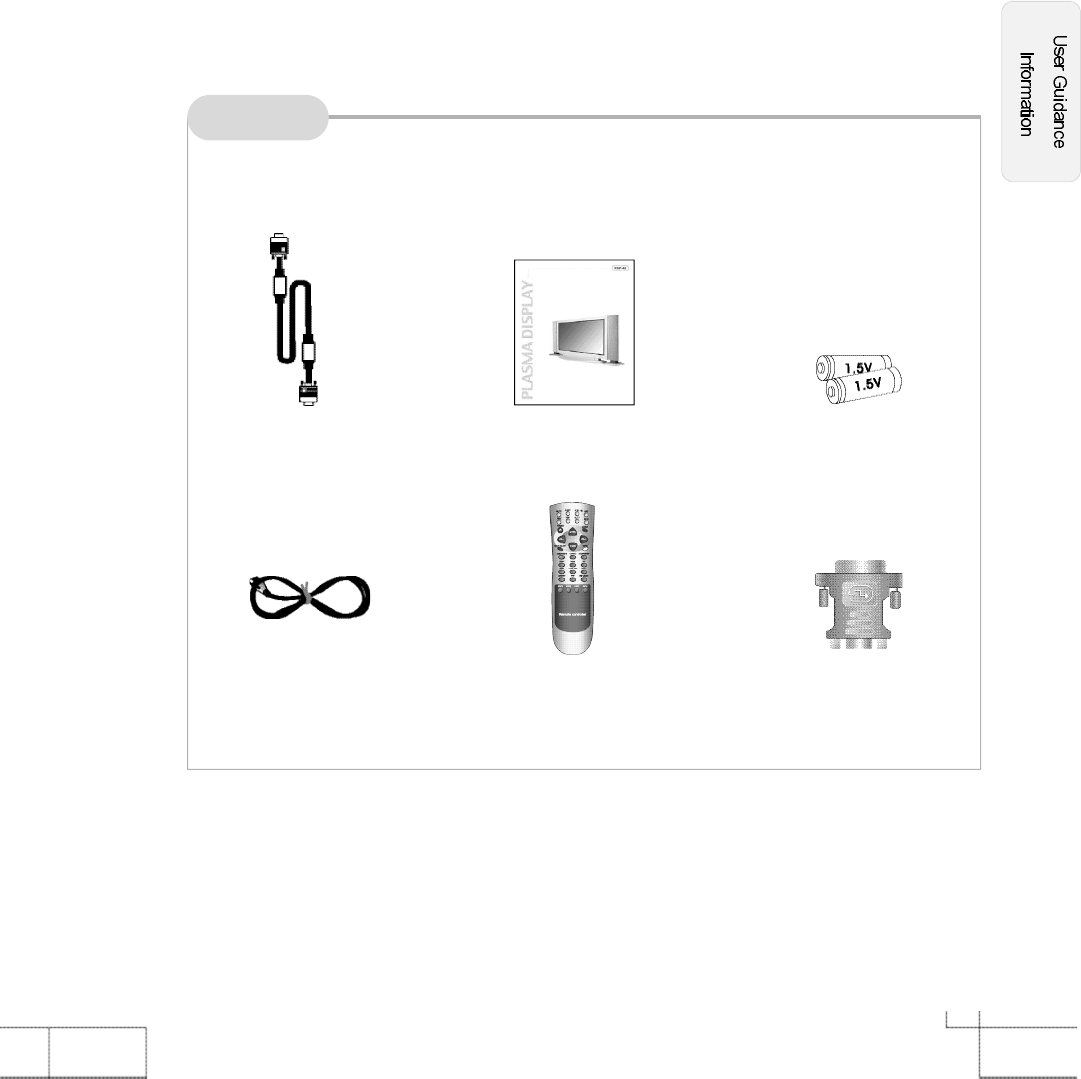
1 1
Accessories
RGB Cable
Power Cords Remote Control
User's Manual
Battery 1.5V( AAA×2)
DVI Adapter
※
The configuration of the components may look different from the following illustrat
i
on.
Manual
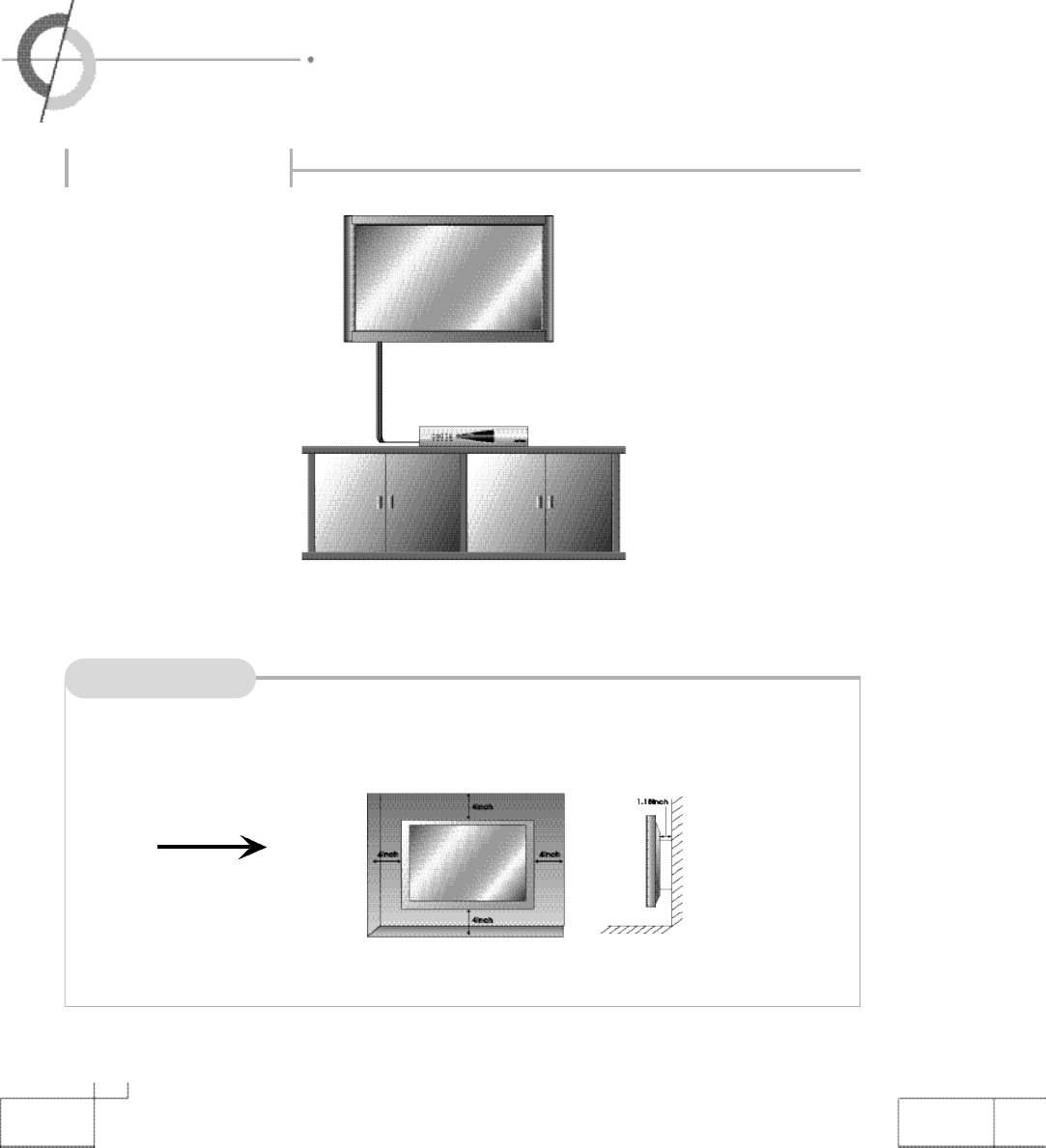
1 2
・Installing the PDP
Things to consider
Installing on the wall
▶
You can install PDP in wall-mounted style as shown in the figure above.
※
Contact your dealer to purchase the "Adjustable-angle wall mount" required for wall-mounted installation.
(
Usage of wall-mount)
A
・Please secure enough space for safe use. (Please refer to A and B.)
・
Installation of the PDP in an improperly ventilated location can cause a fire or damage to the
PDP due to increased temperature.
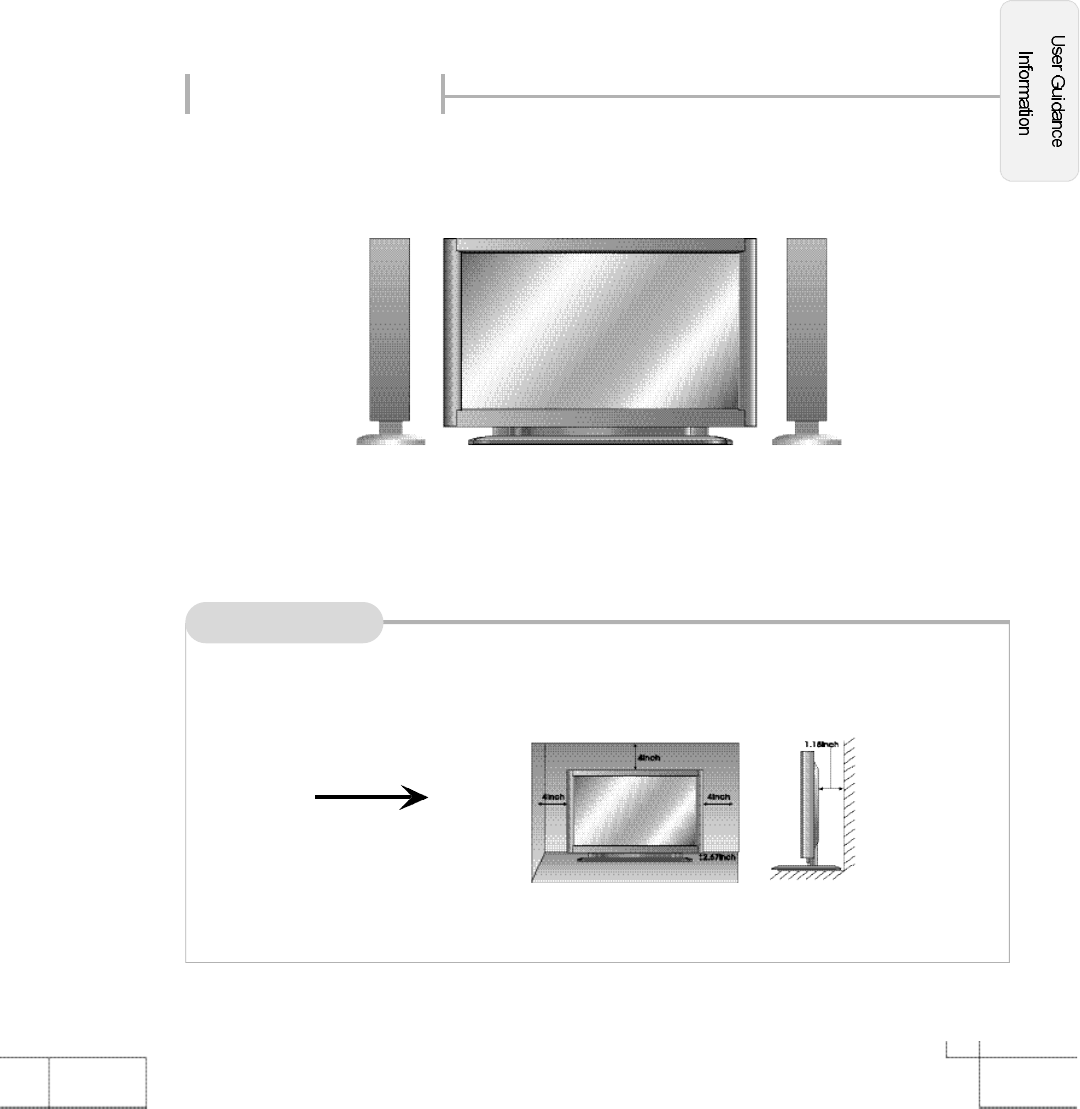
1 3
Installing on a desktop
Things to consider
▶
You can install PDP in a desktop style as shown in the figure above.
※
Please contact your dealer to purchase the "speakers".
B
・Do not install on an unstable location with support area smaller than the PDP.
・Please refer to the desktop stand user's manual for details of installation.
(
Usage of stand)
・
This is not floor-standing unit.
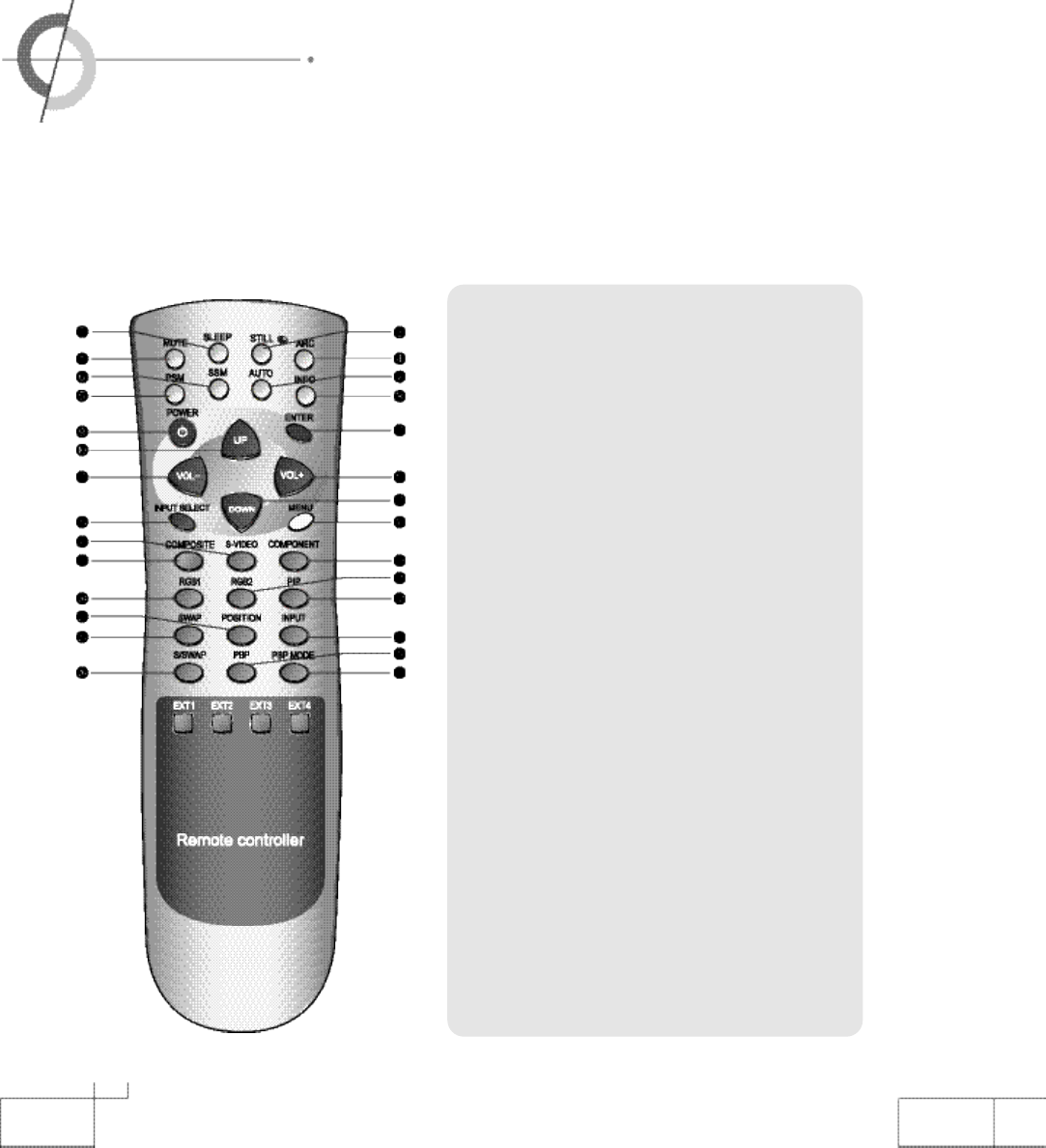
1 4
・Remote controller
※
Functions of remote control buttons
The remote control is using Infra-Red (IR). Point it towards the front of the PDP. The remote control may not work
correctly if it is operated out of range or out of angle.
MUTE :
SOUND MUTE KEY
SLEEP :
SLEEP TIMER KEY
STILL :
FREEZE KEY
ARC :
ASPECT RATIO CONTROL KEY
(4: 3, 16 : 9, Zoom, Panorama)
PSM :
PICTURE STATUS MEMORY KEY
(Standard, Dynamic, Movie, Mild, Game, User)
SSM :
SOUND STATUS MEMORY KEY
(Standard, Music, Movie, Speech, User)
AUTO :
RGB1(ANALOG RGB) INPUT SIGNAL ADJ
INFO :
INFORMATION DISPLAY KEY
POWER :
POWER ON/OFF KEY
UP :
MENU CONTROL KEY
DOWN :
MENU CONTROL KEY
VOL-:
VOLUME
-
OR MENU CONTROL KEY
VOL+ :
VOLUME
+
OR MENU CONTROL KEY
ENTER
INPUT SELECT :
MAIN INPUT SOURCE SELECT KEY
MENU :
OSD MENU DISPLAY KEY
COMPOSITE :
COMPOSITE INPUT SELECT KEY
S-VIDEO :
S-VIDEO INPUT SELECT KEY
COMPONENT :
COMPONENT INPUT SELECT KEY
RGB1 :
ANALOG RGB INPUT SELECT KEY
RGB2 :
DIGITAL RGB INPUT SELECT KEY
PIP (ON/OFF, SIZE LARGE/ SMALL)
:
PIP ON/OFF AND PIP SIZE (LARGE/ SMALL) CONTROL KEY
SWAP :
PIP SWAP KEY
PIP POSITION :
PIP POSITION SELECT KEY
INPUT :
PIP INPUT SELECT KEY
S/SWAP :
SOUND SWAP KEY
PBP :
PBP ON/OFF KEY
PBP MODE :
PBP MODE CONTROL KEY (16 : 9 / 4 : 3)
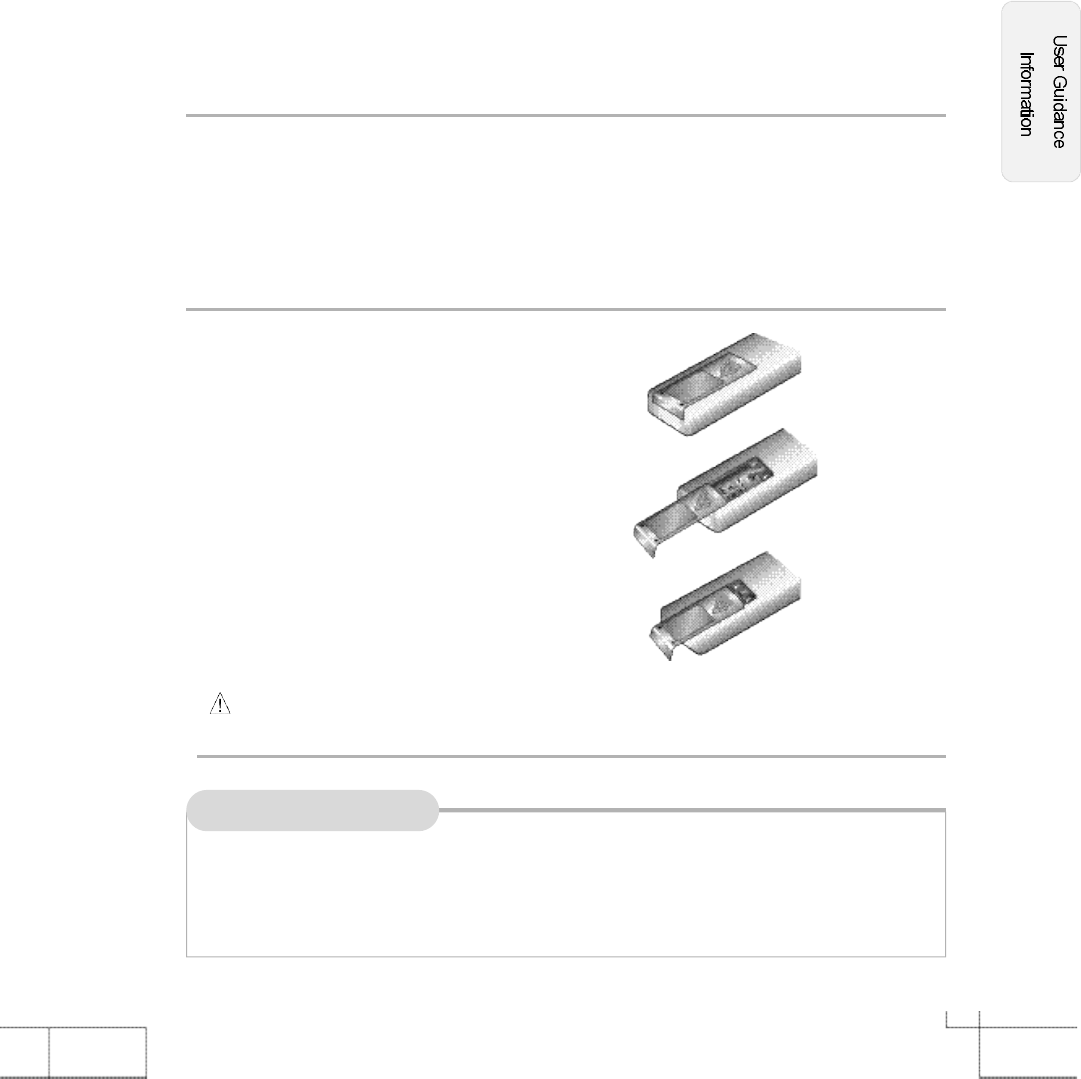
1 5
If remote control does not work
1. Check the polarity (+,-) of the batteries in the remote control.
2. Check that the batteries have power.
3. Check that the PDP is powered and that it is properly plugged in.
4.
Check if any three-wavelength lamp, special fluorescent or neon sign is turned on near the PDP.
How to use remote control
Inserting batteries into remote control
1. Firmly press the ▼part on the
cover and slide the cover in the
direction indicated by the arrow.
2.
Insert the batteries, making sure that
the polarities are correct.
3. Close the cover.
CAUTION : Risk of explosion if battery is replaced by an incorrect type.
Dispose of used batteries according to the national code (Recycling program).
・
The remote control should be operated within 3
0feet(7m) and 30˚to the left and the right of
the IR receiver on the front of the PDP.
・
Used batteries should be disposed properly.
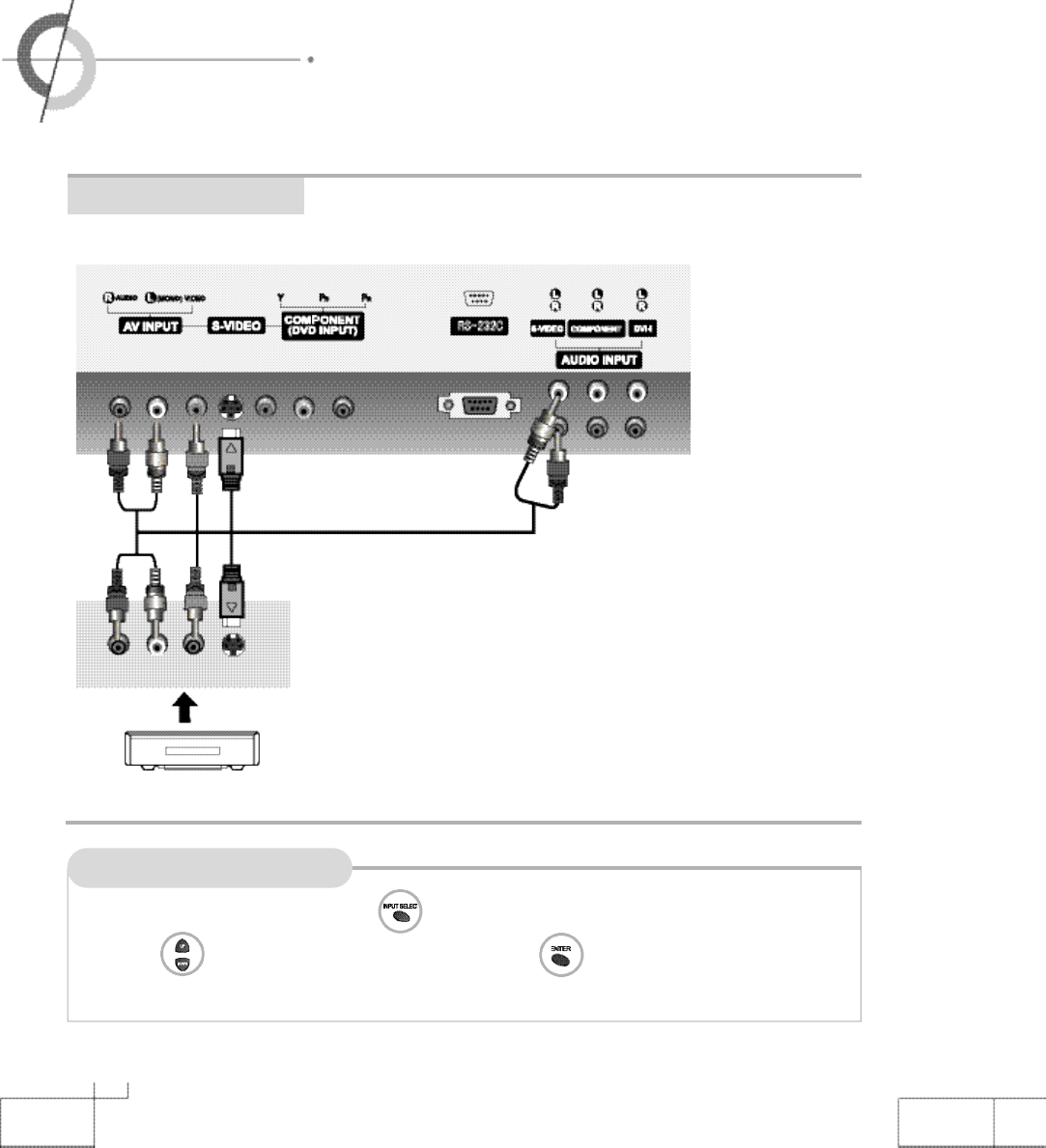
1 6
・Connecting to the VCR
・Connecting to the Cable TV
How to watch VCR on the PDP
Connecting to the VCR
1. Turn on the PDP monitor and press on the remote control.
2. Use to select Composite or S-Video and then press .
3. Turn on the VCR, insert the tape and then press the Play button.
Connecting to the AV Input (composite) terminal
Connect the audio/video cable from audio/ video output terminal of VCR
to the AV Input terminal of PDP. (yellow is for video, white is for audio
(left), red is for audio (right)).
Connecting to the S-Video terminal
(Use S-Video cable for better image)
Connect the S-Video cable from S-Video terminal of VCR to S-Video ter
-
minal of the PDP.
Connect the audio cable from the audio output terminal of VCR to the S-
Video audio input terminal of PDP.
< VIDEO >
A u d i o V i d e o S - V i d e o
( R ) ( L )
<Back view of the Monitor>
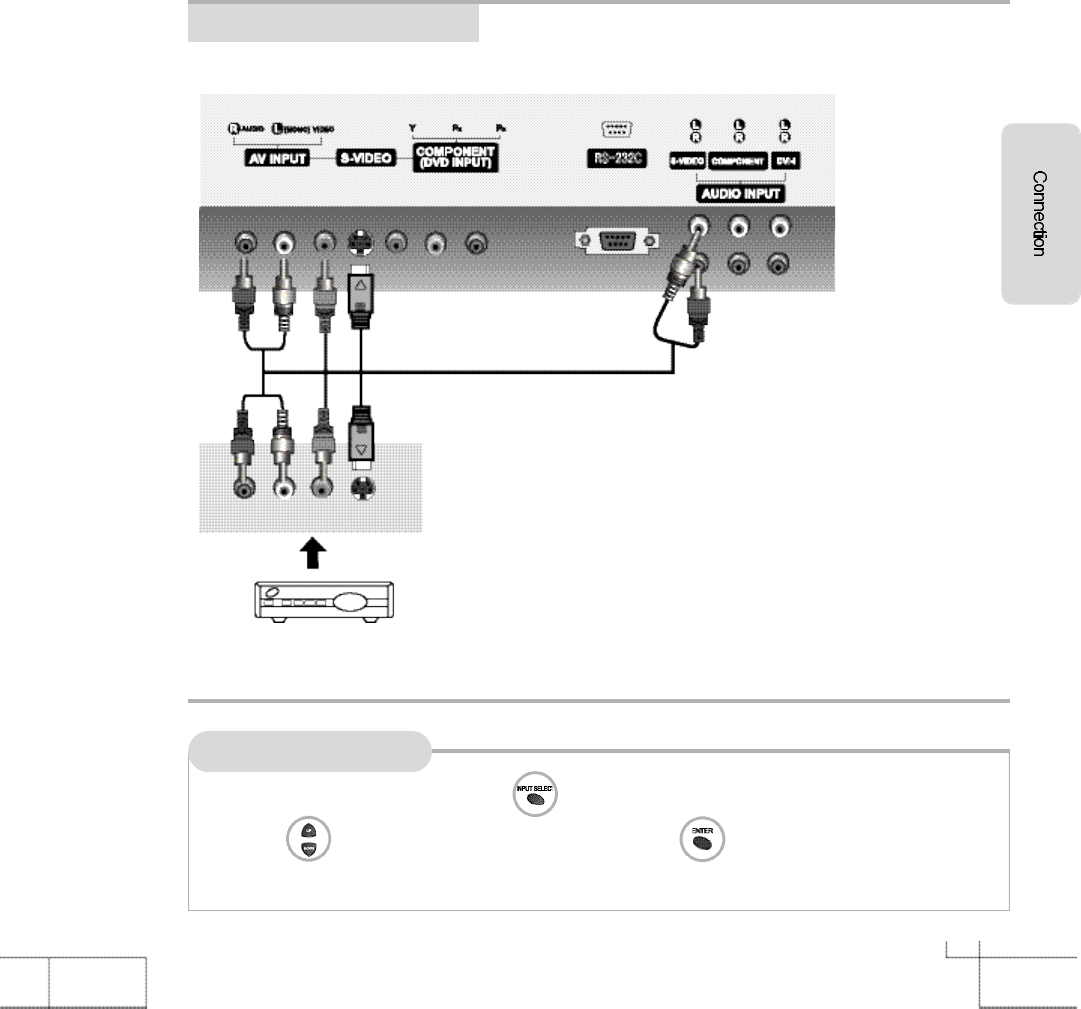
1 7
Connecting to the Cable TV
How to watch a cable TV
1. Turn on the PDP monitor and press on the remote control.
2. Use to select Composite or S-Video and then press .
3. Turn on Set-Top-Box and then select the channel you want.
In order to watch cable TV, subscribe to your local cable TV company
and install a separate converter (Set-Top-Box).
Connecting to the AV Input (composite) terminal
Connect the audio/ video cable from audio/ video output terminal of the Set-
Top-Box to the AV Input terminal of PDP. (yellow is for video, white is for
audio (left), red is for audio (right)).
Connecting to the S-Video terminal
(Use S-Video cable for better image)
Connect the S-Video cable from S-Video terminal of Set-Top-Box to S-
Video terminal of the PDP.
Connect the audio cable from the audio output terminal of Set-Top-Box to
the S-Video audio input terminal of PDP.
<Back view of the Monitor>
<Cable broadcasting receiver >
A u d i o V i d e o
S - V i d e o
( R ) ( L )
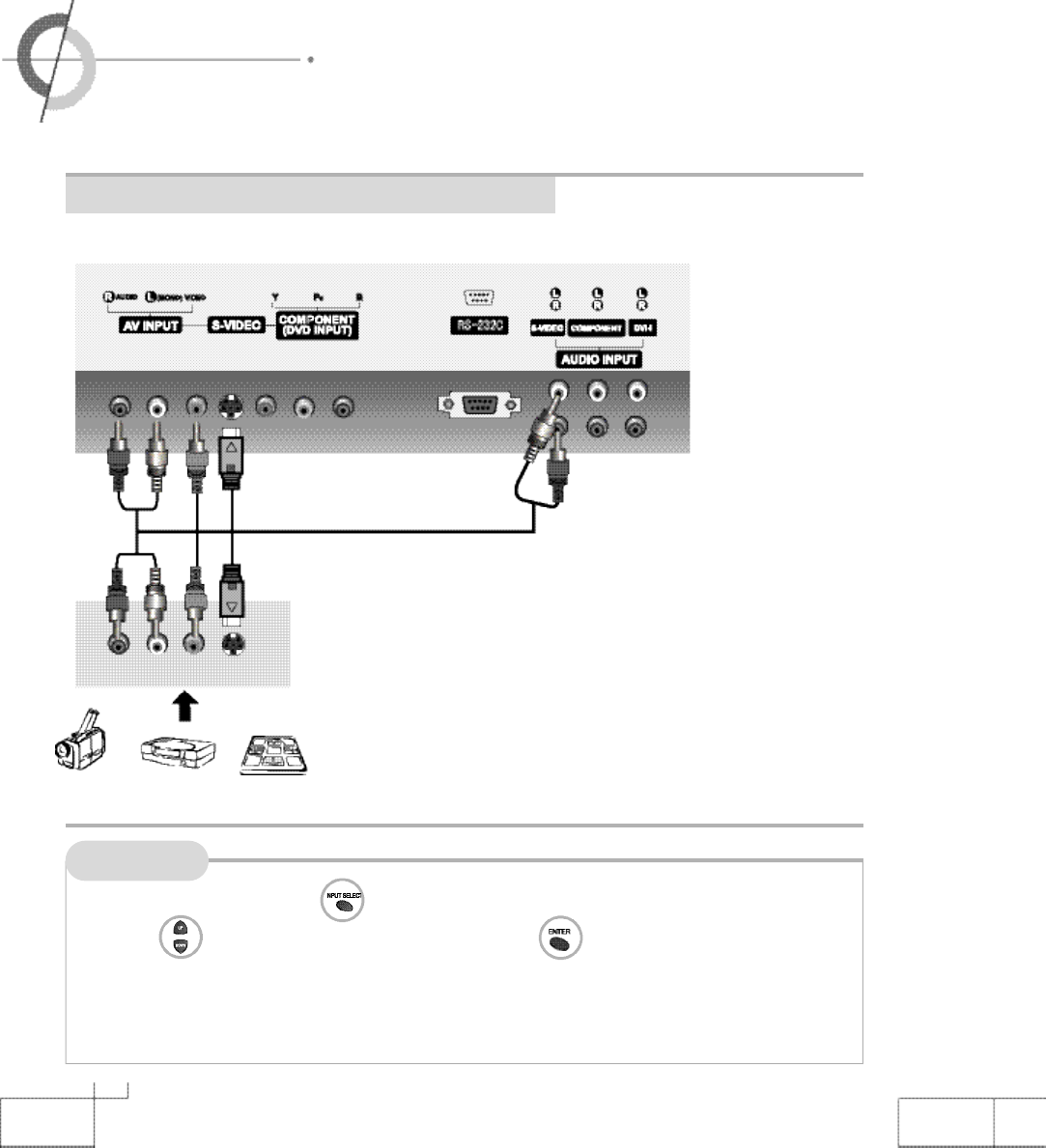
1 8
・Connecting to the Camcorder/ Video game console
・Connecting to the DVD player
How to watch
Connecting to the Camcorder/ Video game console
Connecting to the AV Input (composite) terminal
Connect the audio/ video cable from audio/ video output terminal of the
camcorder/ video game console to the AV Input terminal of the PDP. (yel
-
low is for video, white is for audio (left), red is for audio (right)).
Connecting to the S-Video terminal
(Use S-Video cable for better image.)
Connect the S-Video cable from the S-Video terminal of camcorder/video
game console to the S-Video terminal of PDP.
Connect the audio cable from the audio output terminal of camcorder/
video console unit to the S-Video audio input terminal of PDP.
<Back view of the Monitor>
<Camcorder/ Game machine>
A u d i o V i d e o
S - V i d e o
( R ) ( L )
1. Turn on the PDP and press on the remote control.
2. Use to select Composite or S-Video and then press .
3. Turn on the camcorder or video game and set to video mode.
(Please refer to the user's manual of camcorder/video game for more information.)
4. Insert tape into camcorder and press Play button or insert disc into the video game console.
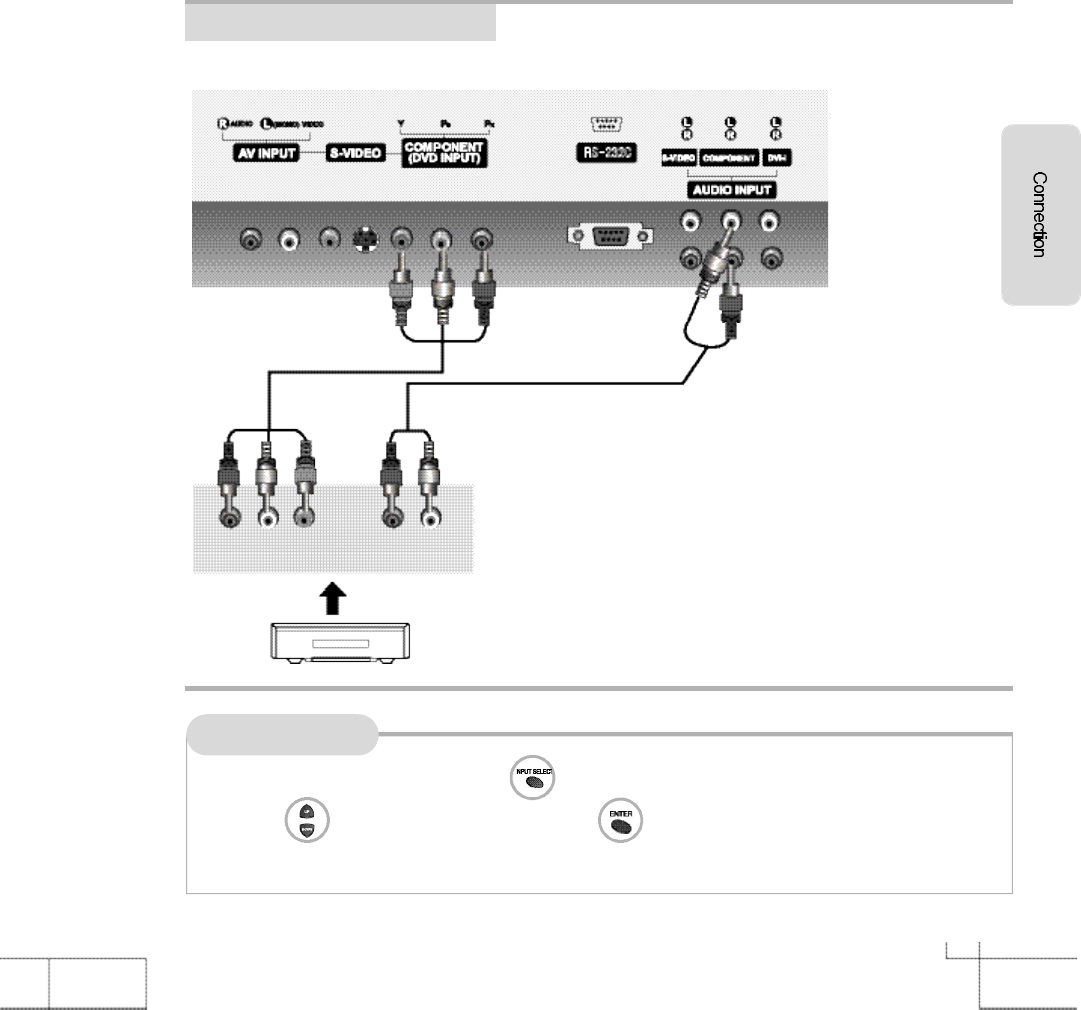
1 9
How to watch DVD
Connecting to the DVD player
1. Turn on the PDP monitor and press on the remote control.
2. Use to select component and then press .
3. Turn on DVD player and press Play button.
Connecting to the component terminal
・
Connect component video cable from the component video out-
put terminal of DVD player to the component terminal (Y, P
B
,
P
R
) of the PDP.
・
Connect audio cable from the audio output terminal of DVD
player to the component audio input terminal of the PDP.
・
You can make S-Video connection or AV Input (composite) con
-
nection instead of connecting to component terminal. (Please
refer to page 16 on connection method)
・
DVD component output terminal is indicated by Y, P
B
, P
R
or Y,
C
B
, C
R
.
<Back view of the Monitor>
< D V D >
A u d i oV i d e o
P
R
P
B
Y
( R ) ( L )
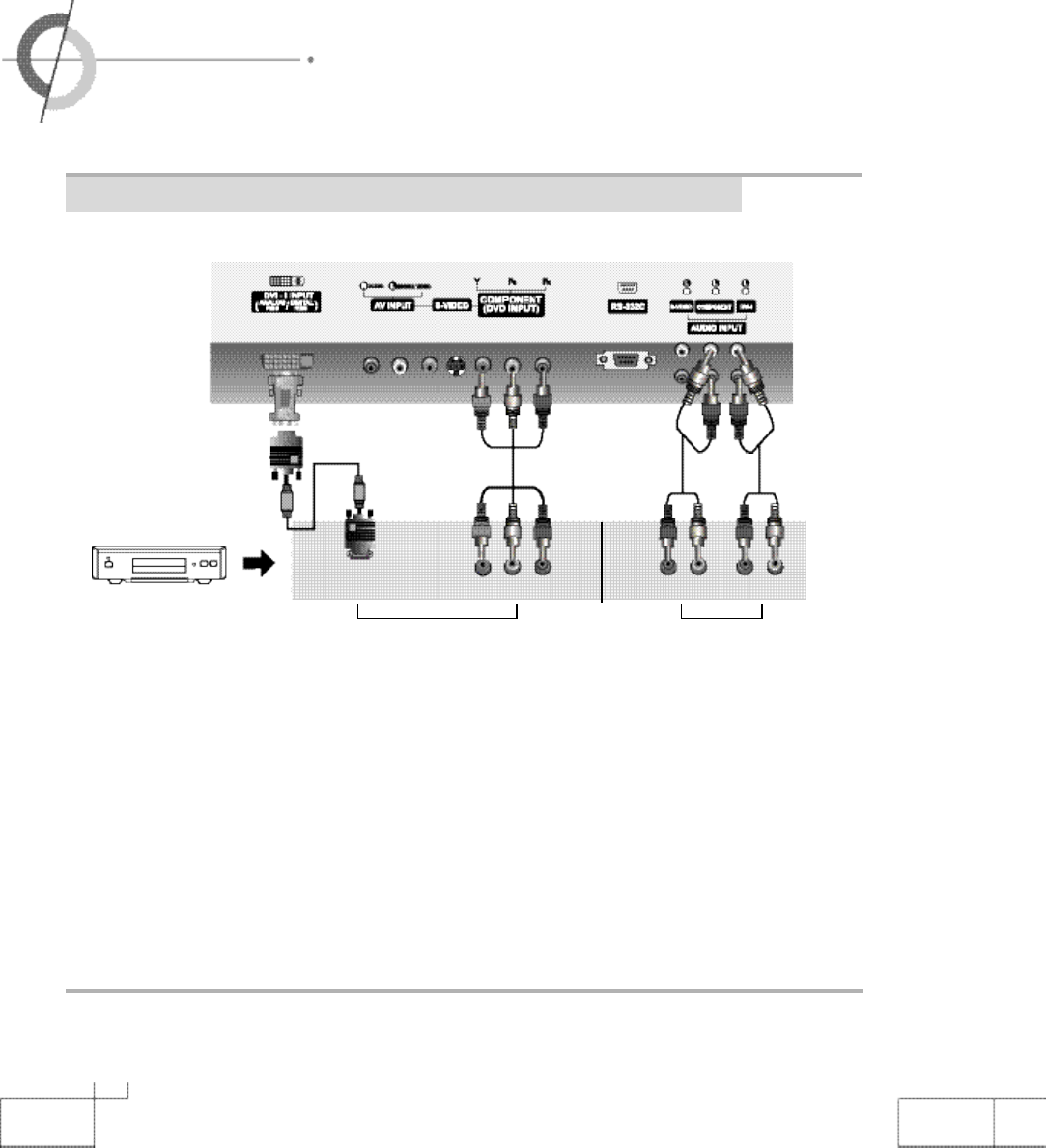
2 0
COMPONENT RGBCOMPONENT
RGB
・
Connecting to the DTV receiver
Connecting to the Component terminal/ Connecting to the DVI-I terminal
Connecting to the component terminal/ Connecting to the RGB terminal
・
A separate Set-Top-Box may be required to receive digital broadcasting.
・
In 1080i mode of DTV mode, the screen size selection is disabled, but fixed to 16:9 the screen size
does not change.
Connecting to the component terminal
Connect component video cable from the component video output terminal of DTV receiver to the com
-
ponent terminal (Y, P
B
, P
R
) of the PDP.
Connect audio cable from the audio output terminal of DTV receiver to the component audio input termi
-
nal of the PDP.
・
You can make S-Video connection or AV-Input connection instead of connecting to component termi
-
nal. (Please refer to page 16 on connection method)
・
DTV component output terminal is indicated by Y, P
B
, P
R
or Y, C
B
, C
R
.
<Digital broadcasting> V i d e o
<Back view of the Monitor>
P
R
P
B
Y
( R ) ( L ) ( R ) ( L )
A u d i o
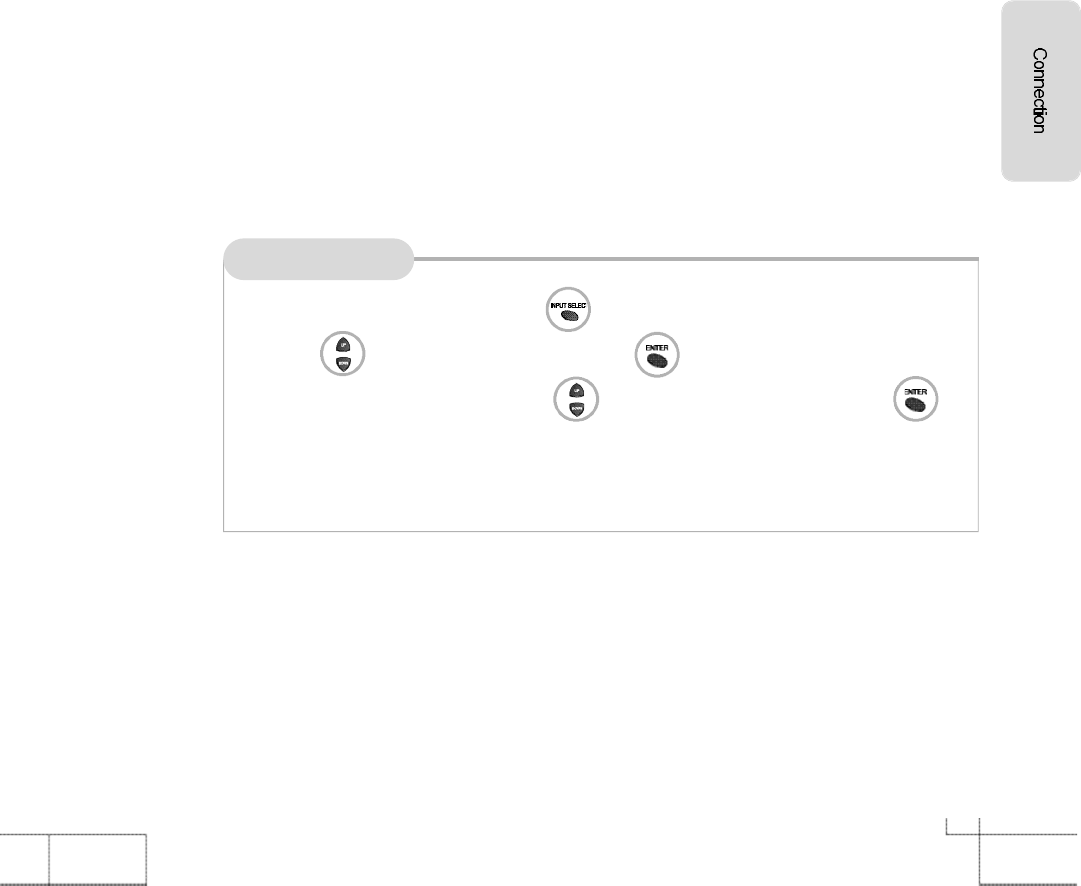
2 1
How to watch DTV
1. Turn on the PDP monitor and press on the remote control.
2. Use to select component and then press .
3. When c
onnecting DVI-I terminal, use to select RGB1(Analog) and then press .
4. Turn the DTV receiver on and select the channel that you want.
・
DTV video output of 480p or 720p will show the clear and detail image of screen.
Connecting to the DVI-I terminal
Some of DTV receivers (Set-Top-Box) have an RGB connector (D-sub 15 pin) instead of a component
output. The DVI adapter, which provides this connection terminal for the PDP, may be used for this con
-
nection.
Connect the DVI adapter into the VGA cable and connect to the PDP DVI-I input terminal. Connect the
other end of the cable to D-sub output terminal of DTV receiver.
Connect audio cable from the audio output terminal of DTV receiver to the DVI-I audio input terminal of
the PDP.
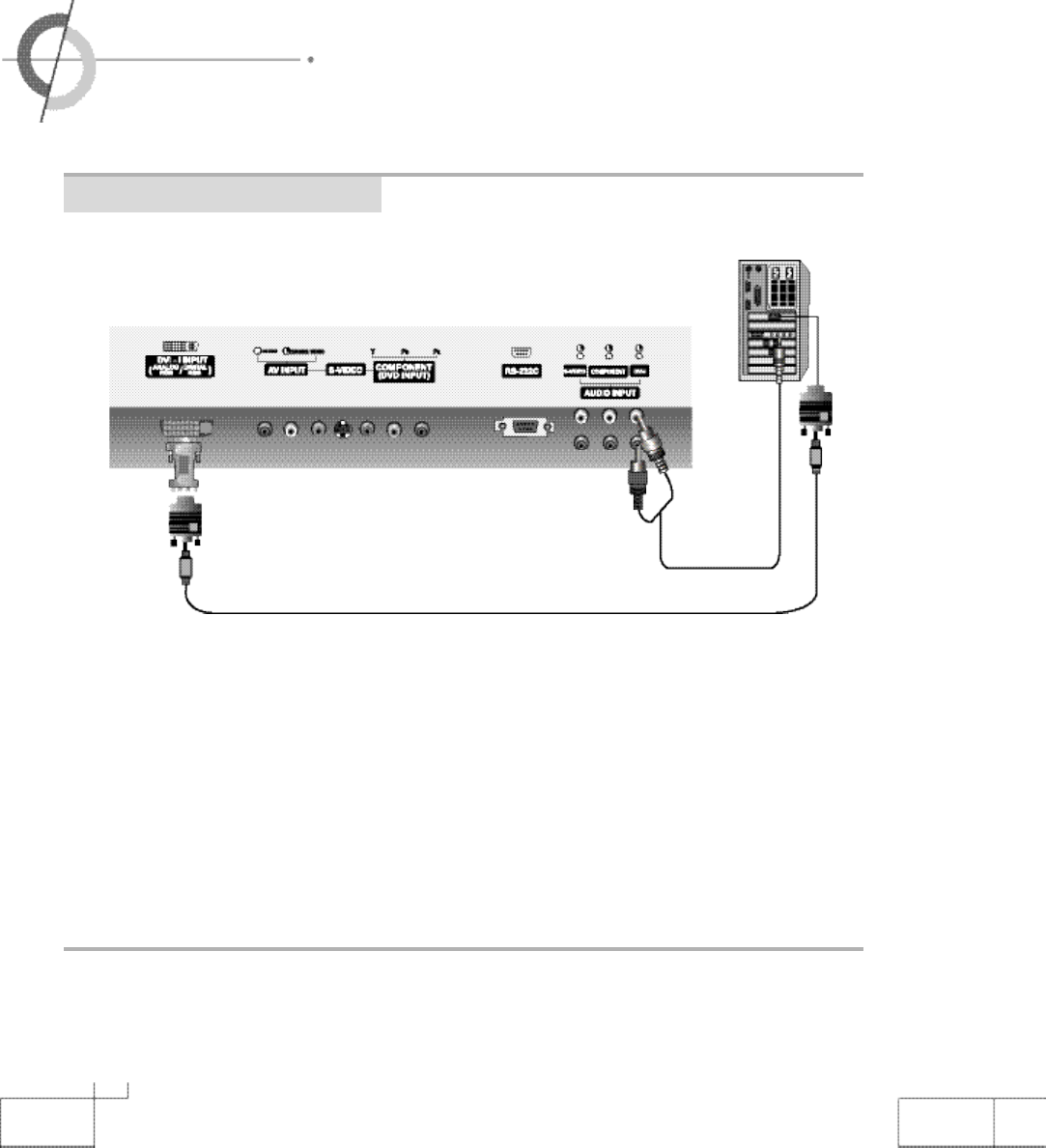
2 2
・Connecting to the PC
Connecting to the DVI-I terminal
Connecting to the Analog RGB
Connecting to the Analog RGB terminal
Connect DVI adapter into VGA D-Sub cable, then connect to the PDP DVI-I input terminal. Connect the
other end of the VGA Cable to D-sub Video output terminal of PC.
Connect audio cable from the audio output terminal of PC to DVI audio input terminal of the PDP.
(PC audio cable is not included and should be purchased separately.)
※PC audio works only if a Sound Card is installed.
Connecting to the Digital RGB
Connect DVI cable from the DVI output terminal of PC to the DVI-I input terminal of the PDP.
Connect audio cable from the audio output terminal of PC to the DVI audio input terminal of the PDP.
(The DVI cable and the audio cable should be purchased. Contact your dealer.)
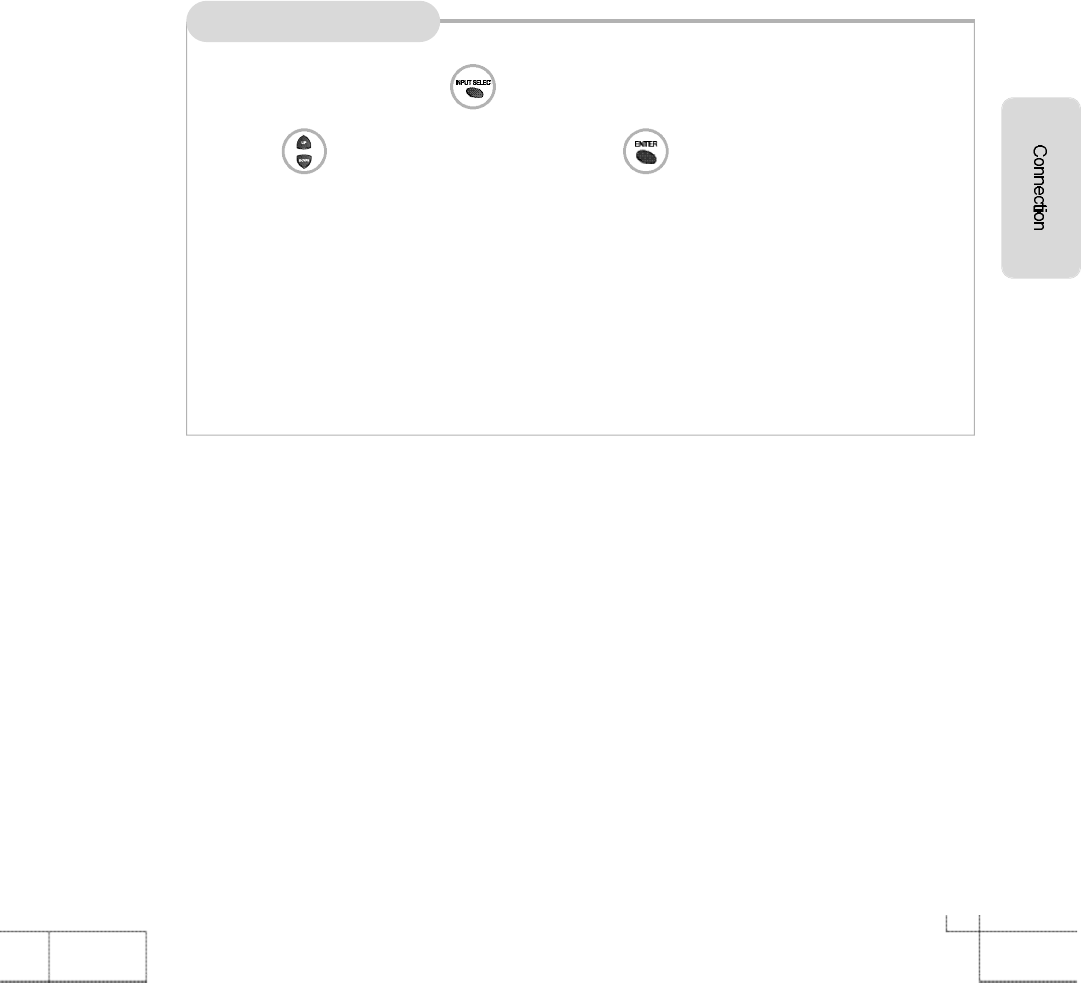
2 3
How to use as PC Monitor
1. Turn on the PDP and press on the remote control.
2.
Use to select RGB1(Analog) and then press .
(If the PC output is set to Digital, select RGB2(Digital).)
3. This PDP does not support Plug & Play function. When setting the PDP, select default.
4.
Set the PC video output mode to VGA (640
×480)/ SVGA (800×600)/ XGA (1024×768). In the
mode higher than SXGA (1280×1024), "Out of Range" message appears. Be sure to change
your PC video format to less than XGA mode. (Please refer to page 51 for the modes that PDP
supports)

2 4
・
Powering the PDP
・Selecting input source
Prior to using the PDP
Insert the power plug.
Connect external equipment properly.
・Please use only after carefully reading this manual.
・
Check the power connection to the AC outlet and the connection of AC input to the PDP.
Power On/ Off
・
To turn the PDP on :
Press the "Main Power" button of PDP and then press the "Standby" button.
・
To turn the PDP off :
Press "Standby" button on the PDP and then press the "Main Power" button.
Turning the main power switch off will save energy. It is the same as unplugging the power cord.
If ON Time setting is set, the main power should be ON.
・
To turn on/off by remote control :
Press the POWER button of remote control (If the PDP is not turned on, check that the "Main Power"
button on the PDP main body is turned on. The main power indicator will light up red if turned on).
CAUTION -
After turning off the main Power, please wait at least more than 3 seconds to turn the
main power back on.
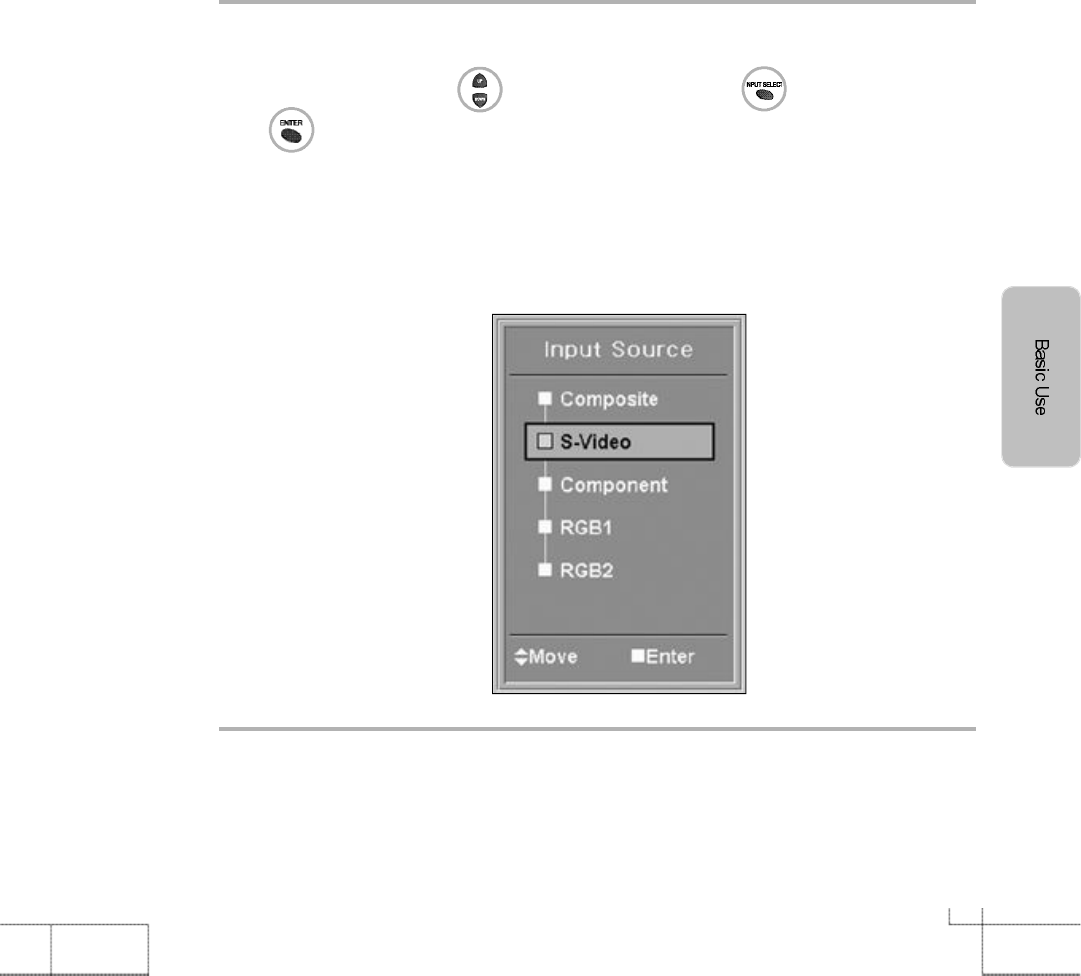
2 5
Selecting input source
Select the required input using in the pop up menu by pressing and then select
with .
Press Composite button, S-VIDEO button, COMPONENT button, RGB1 button, and RGB2 button
on the remote.
Ex) When selecting Analog RGB, press RGB1 button.
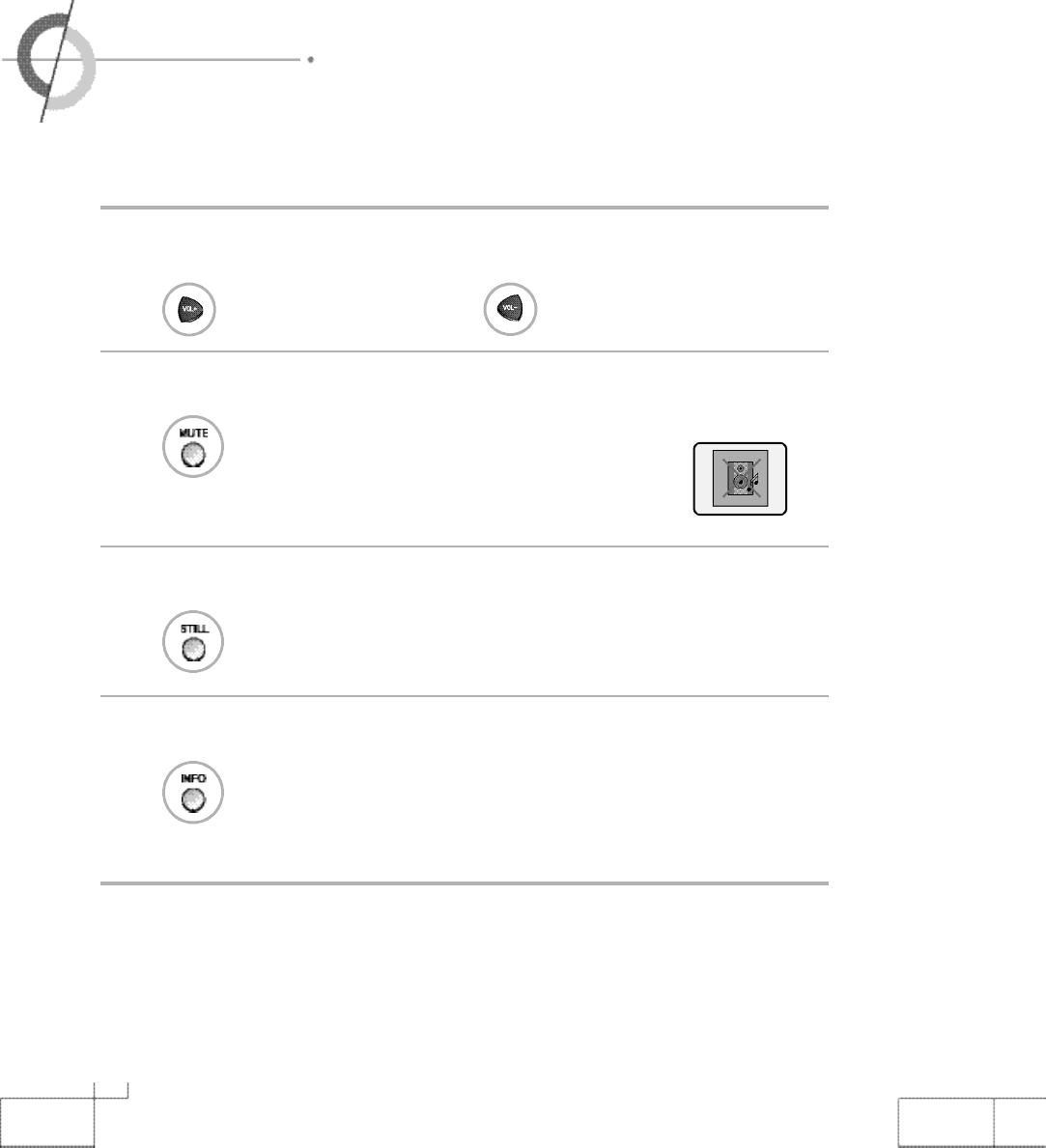
2 6
・VOLUME - Adjusting the volume・MUTE - To mute the sound
・STILL - T
o pause the screen
・INFO - To check the current state
・MENU - Checking the menu
VOLUME - Adjusting the volume
Press for the volume increasing and press or decreasing.
MUTE - To mute the sound
Press . If you press the button again, the sound turns back on.
STILL - To pause the screen
Press . If you press the button again, the screen moves again.
INFO - To check the current state
Press . The current settings are displayed. It automatically disappears after
three (3) seconds.
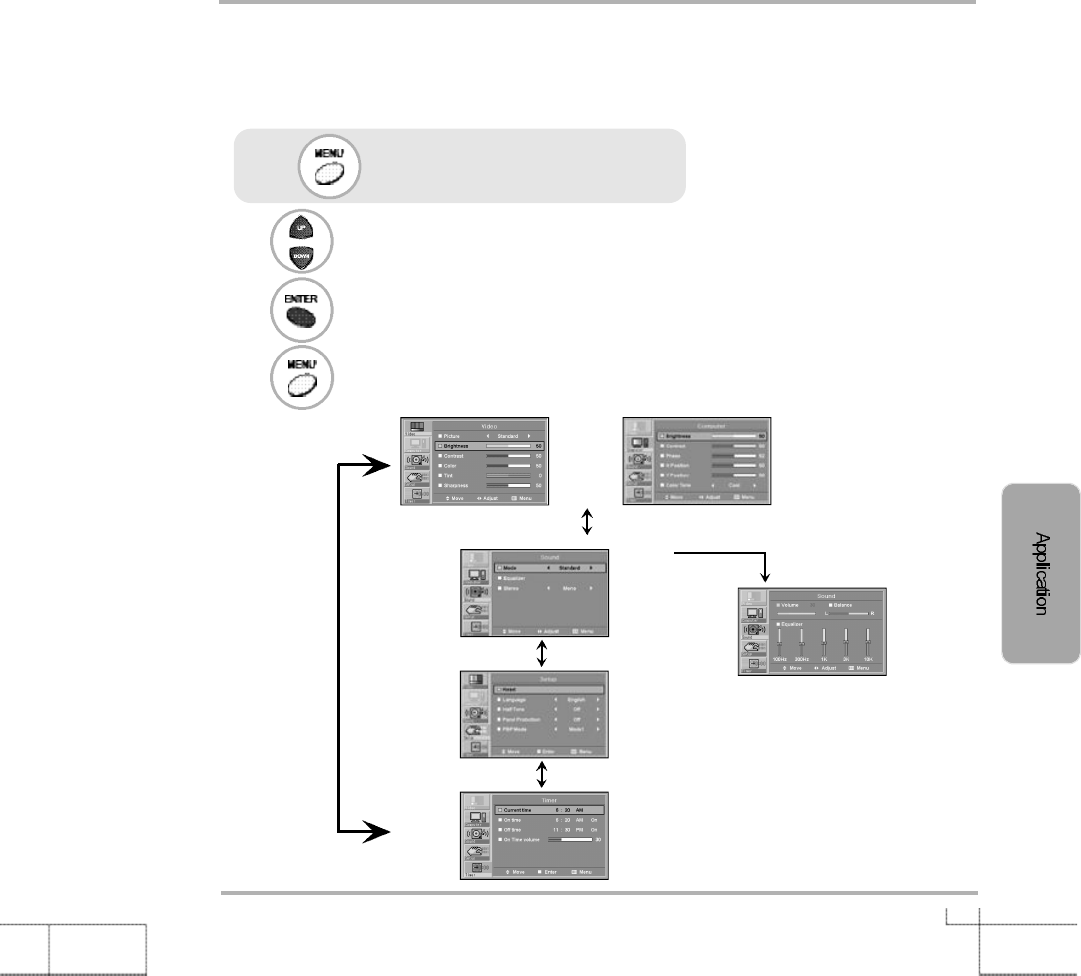
2 7
MENU - Checking the menu
If input selections are "AV Input (composite)", "S-video", and "Component", the video menu is activated.
If input selections are "RGB1" or "RGB2", the computer menu is activated.
The remote control should be used for detailed menu settings and to change the settings.
Press .
Use to move the cursor bar up and down in the menu as shown in the figure.
Use to move to sub menu and store the setting value.
Use to leave the main menu.
[ Video Mode ] [ Computer Mode ]
[ Sound Mode ]
[ Setup Mode ]
[ Timer Mode ]
[ Equalizer ]
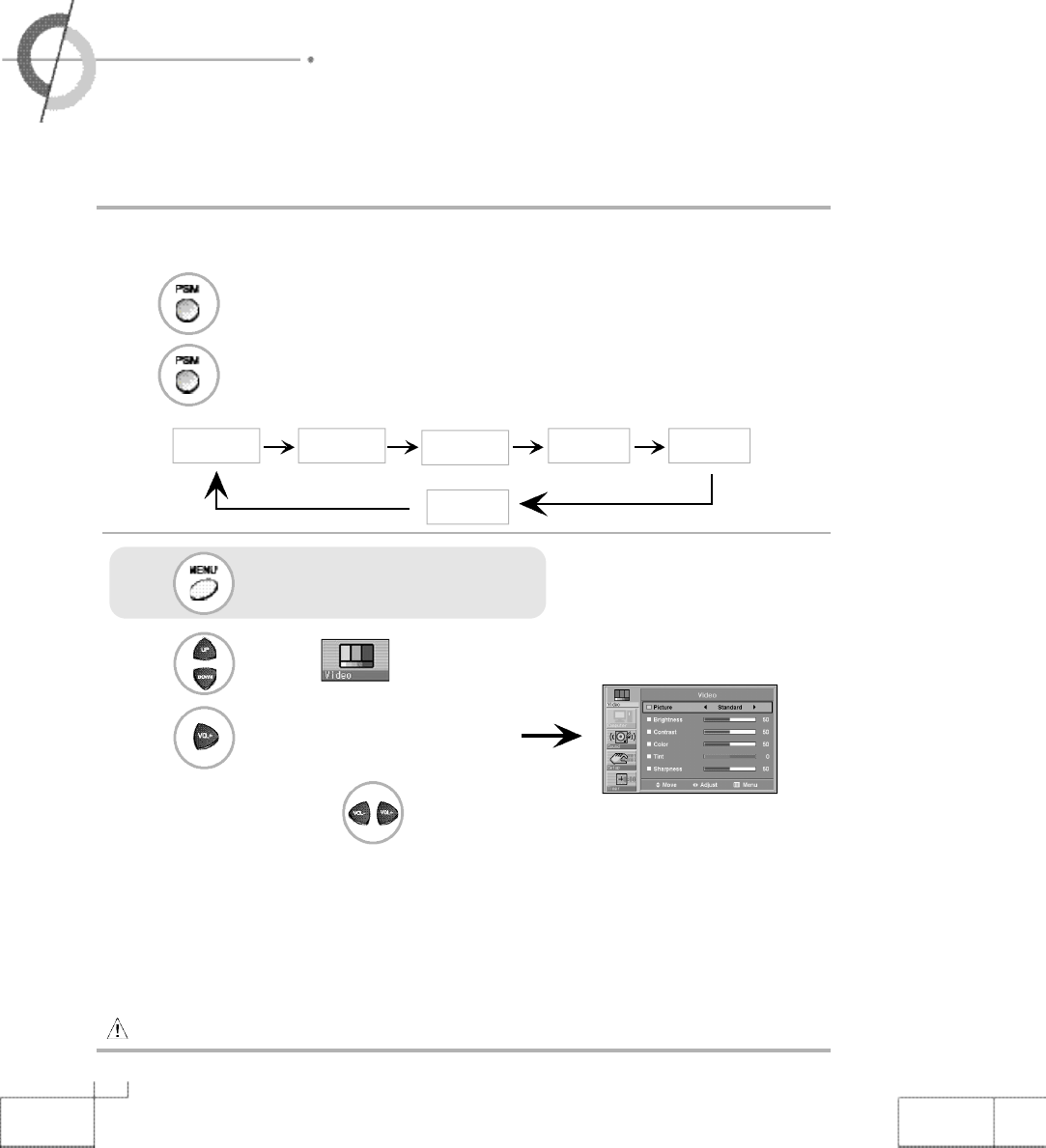
2 8
1. Press to move to .
2. Press to get into a sub menu.
3. Select the required mode with .
・
Standard : It is the best screen setting (factory setting).
・
Dynamic : Select when using the PDP in a brightly lit environment.
・
Movie : Select when watching a movie. Then, *Film mode is operated.
・
Mild : Select when using the PDP in a dimly lit environment.
・
Game : Select to enjoy the Video games.
・
User : Select to set user's preferences.
※
Film mode - It makes video that originated from flim smoother, more continuous.
W a r n i ng
: Shadow image could remain on Dynamic mode due to image sticking phenomenon.
・PSM (Picture Status Memory)
・Adjusting the screen in USER mode
Press .
PSM (Picture Status Memory)
Press .
Press repeatedly to select the desired screen.
Standard Dynamic Movie Mild
Game
User
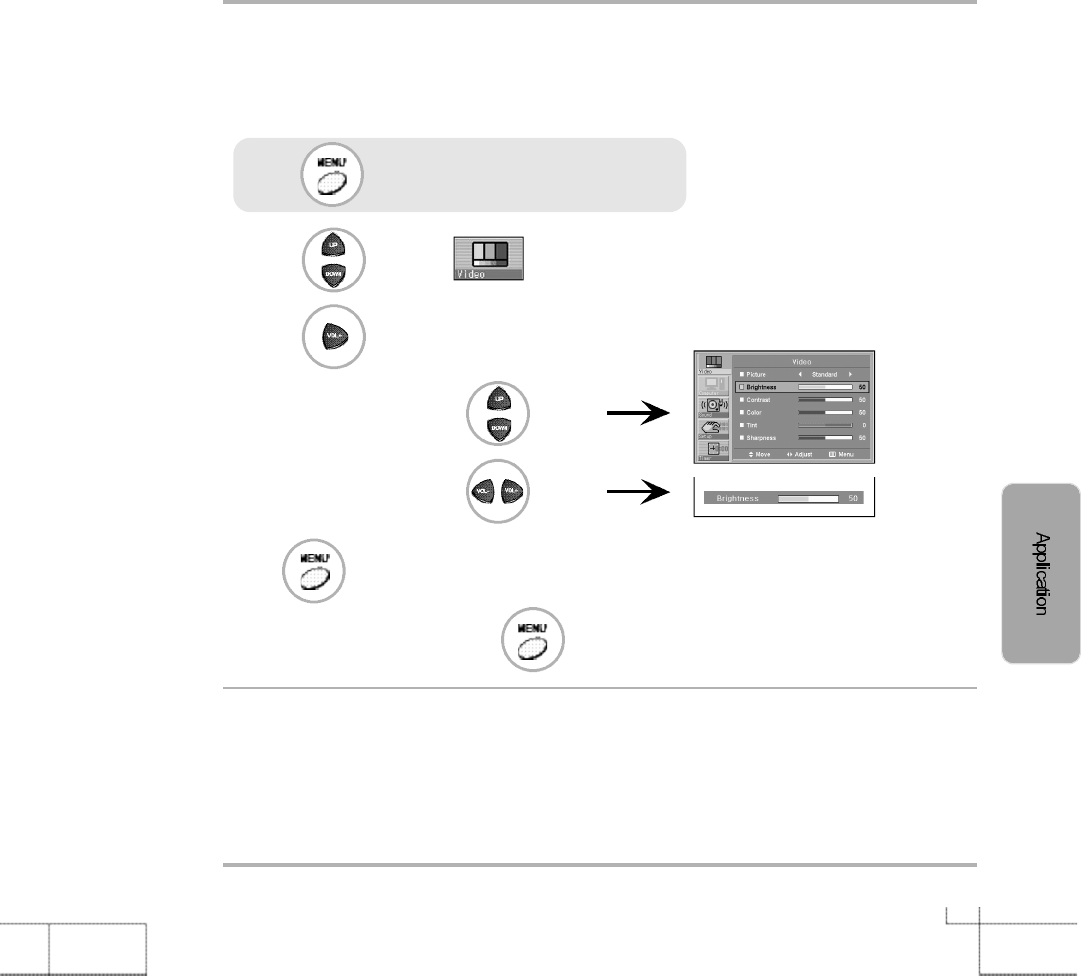
2 9
1. Press to move to .
2. Press to get into a sub menu.
3. Select the item to adjust with .
4. Adjust the setting value with .
Press after the adjustments are made.
To leave from the main menu, press again.
User Mode
・
Brightness : It adjusts the brightness of the image.
・
Contrast : It adjusts the contrast of image.
・
Color : It adjusts the intensity of the color.
・
Tint : It adjusts the natural tint of the image.
・
Sharpness : It adjusts the clarity of the image.
Press .
Adjusting the screen in USER mode
This is available when input signals are one of "AV input
(composite)", "S-Video", and "Component".
・
Adjustment is possible either in one of preset modes or in User mode.
・
User defined values are stored in the User mode.
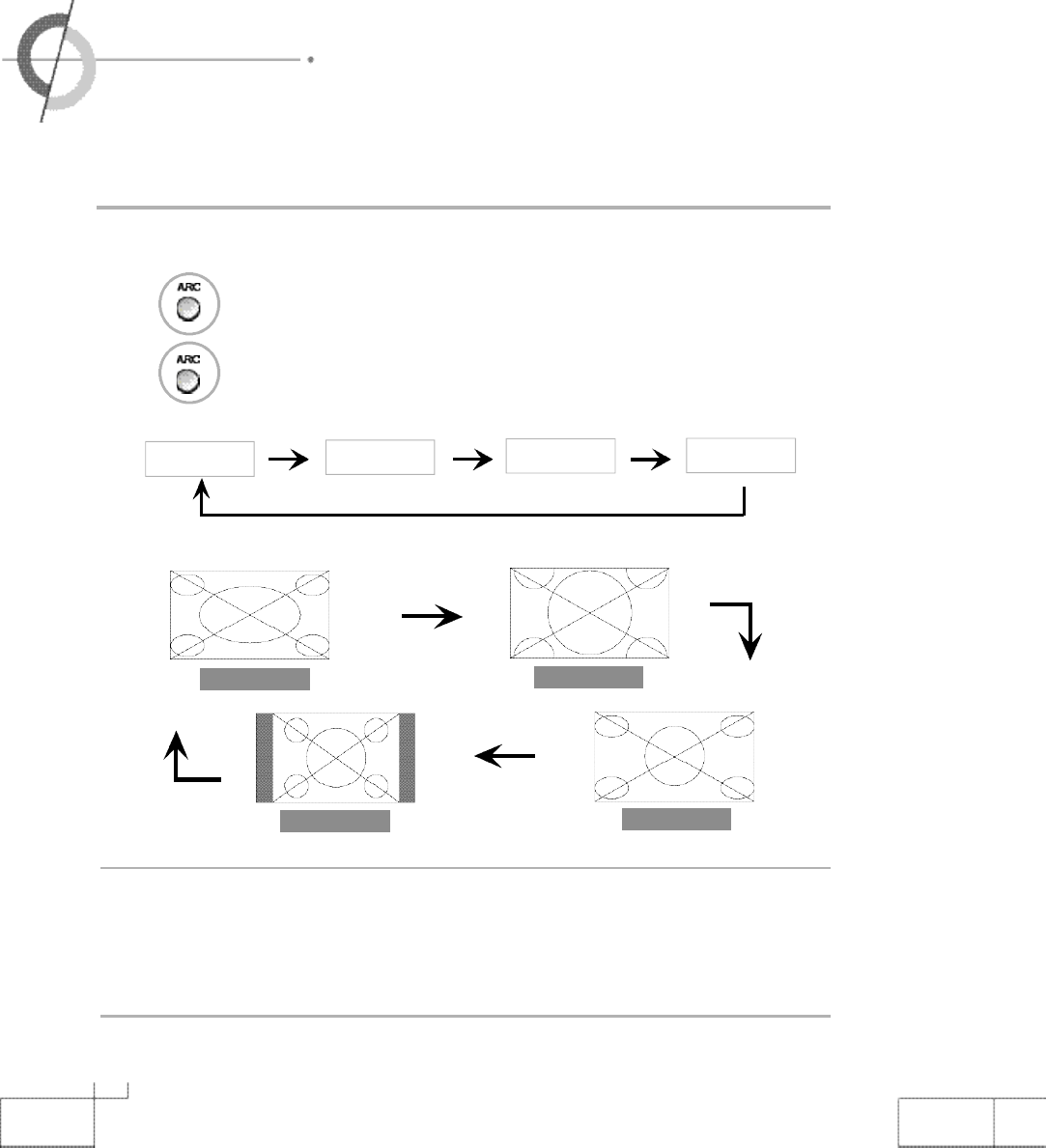
3 0
・ARC (Aspect Ratio Control)
・Watching PIP
ARC (Aspect Ratio Control)
Press .
Press repeatedly to select the desired screen size.
Screen Size
・
16 : 9 - It is a full screen size format.
・
Zoom - It enlarges the natural screen factor by approx. 5 %
・
Panorama - It makes 4:3 format fit into 16 : 9 format with minimal loss in content.
・
4 : 3 - It is the standard format of broadcasting.
16 : 9
Zoom
4 : 3
Panorama
16 : 9
4 : 3
Zoom
Panorama
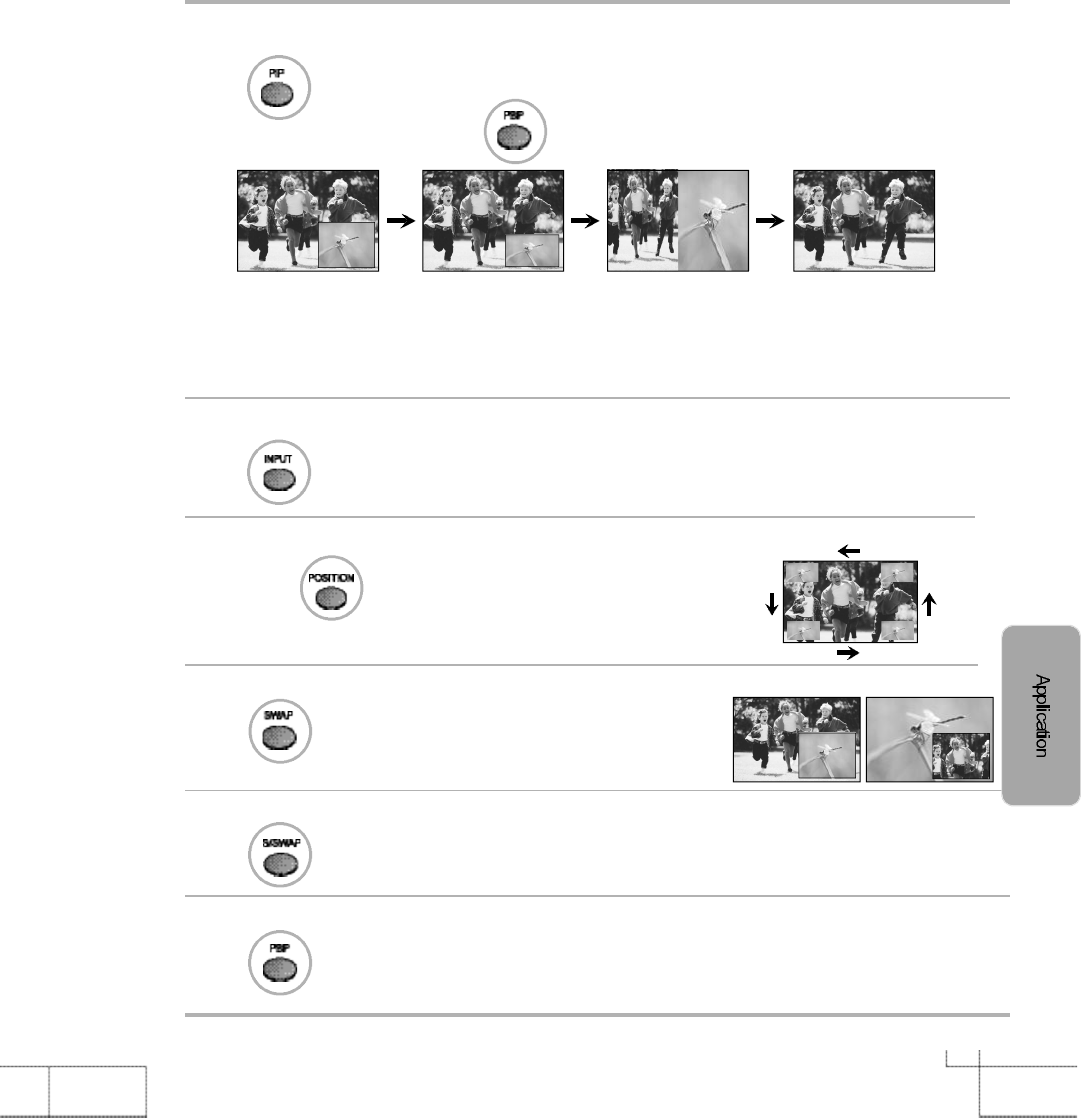
3 1
Watching PIP (Picture In Picture)
Press .
The followings will be displayed : Press
to activate PBP at once.
This function will work on Analog RGB, Digital RGB, Composite, S-video, and Component signals as inputs to
main screen and Composite, S-Video and Component (480i) as inputs to sub-screen.
When watching PIP, the main screen and the sub-screen may have differences in the quality of screen color.
PBP only works in S-Video, Composite, Component (480i) input signals.
PIP Input(Changing the input signal of PIP)
Press .
The following sub-screen will be selected in order :
1. Composite / 2. S-Video / 3. Component.
※Component input will display only 480i input.
PIP position (Moving the sub picture)
As you press
, the location changes as illustrated next.
※
If the sub-screen does not appear, (only a black screen is shown)
check to see that input terminal is connected.
PIP Swap (How to exchange the main screen from sub screen)
Press
, and the main/sub screen will be exchanged.
※This does not work in Analog RGB, Digital RGB, and
Component (480p, 720p, 1080i).
PIP Sound Swap (How to exchange the sound from the main to sub)
Press , the audio of the main/sub screen is exchanged.
PIP [Large] PIP [Small] PBP Normal
PBP MODE (How to exchange the PBP mode)
Press , the mode of the PBP is exchanged from 1
6 : 9 to 4 : 3.

3 2
・PC mode
Auto adjustment
Use this when the Analog RGB input signal is cropped, or not synchronized.
1. Press .
2. You may have to press multiple times to auto-adjust properly.
3. If manual compensation is required, adjust it manually.
※Auto Adjustment works only on Analog RGB signals.
Adjusting the computer screen
This is an auto adjustment for Analog RGB only.
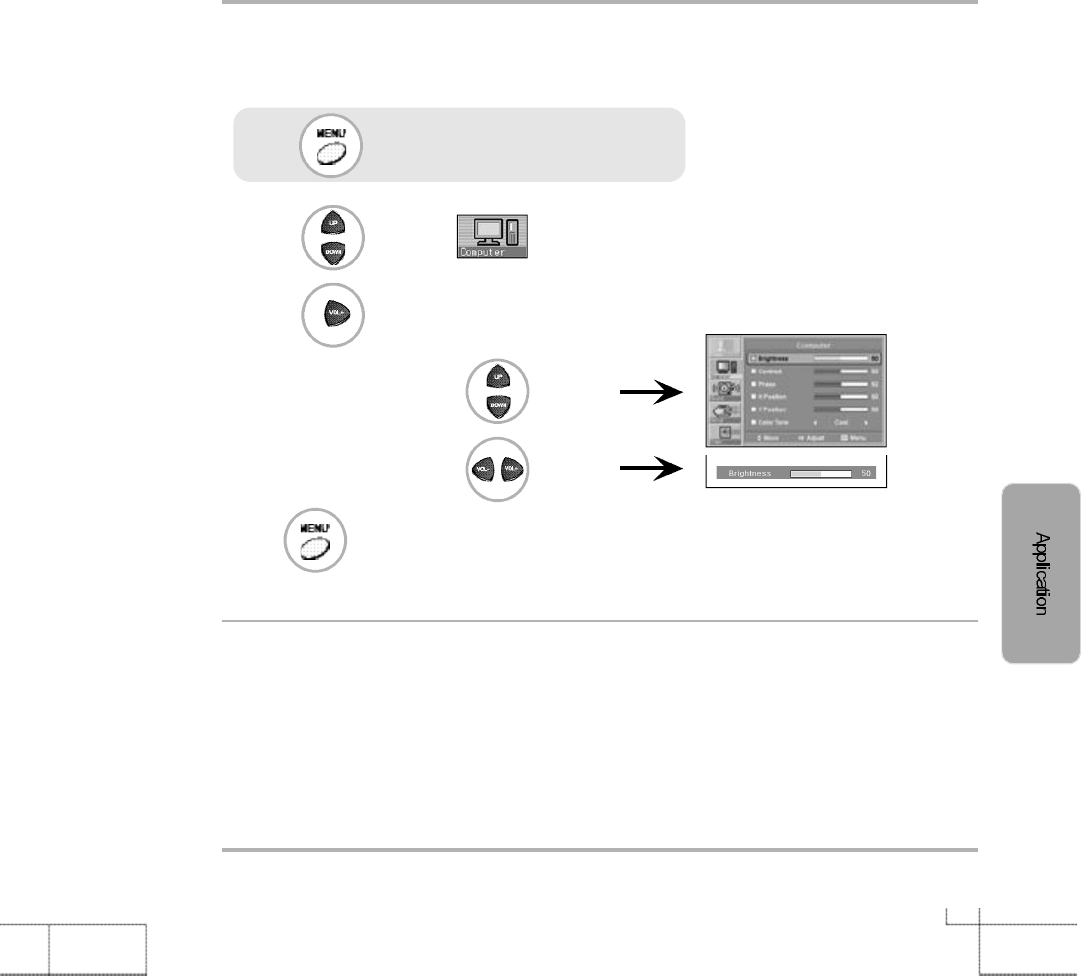
3 3
Press .
Press after making adjustments to return to the previous menu.
Press it again to leave the menu.
Manual adjustment
Use this if fine adjustment is required after auto adjustment.
1. Press to move to .
2. Press to get into the sub menu.
3. Select the item to adjust with .
4. Adjust the setting value w i t h .
User Mode
・
Brightness : It adjusts the brightness of the image.
・Contrast : It adjusts the contrast of the image.
・
Phase : It adjusts the phase shift of the image. Use when image appears blurry or out of focus.
・H-Position : It moves the image on the screen horizontally.
・
V-Position : It moves the image on the screen vertically.
※
Phase, H-Position, V-Position, Color Tone are not adjustable in Digital RGB(RGB2).
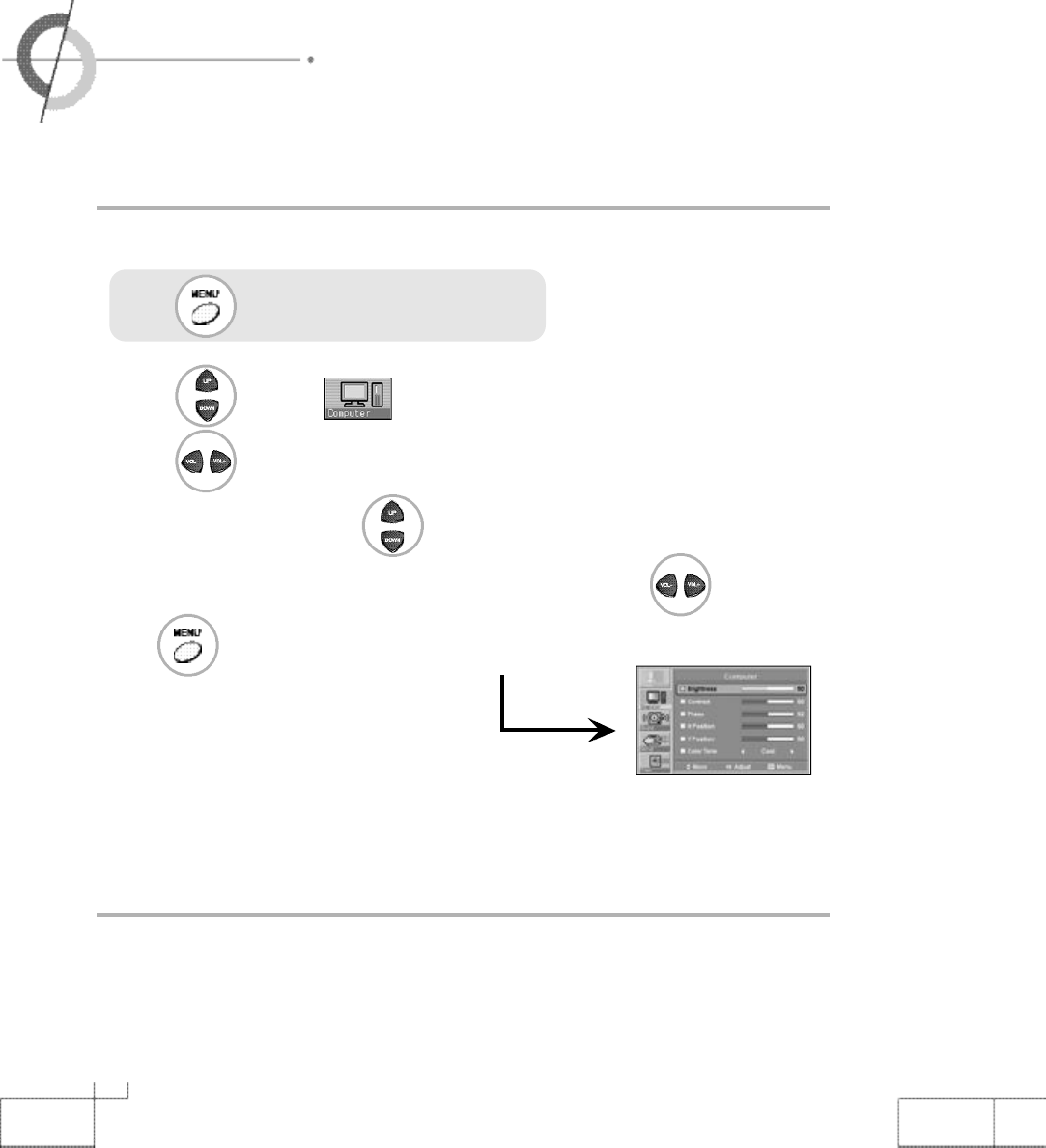
3 4
・Color Tone (Pre-set)
・Color Tone (Manual adjustment)
1. Press to move to .
2. Press to get into a sub menu.
3. Select the item "Color Tone" with .
4. Select the required color among "Cool", "Normal", "Warm", and "User" with
.
Press after making adjustments to return to the previous menu.
Press it again to leave the menu.
Color Tone (Pre-set)
User Mode
・Cool : This results in a blueish tone.
・Normal : This is standard color setting.
・Warm : This results in a reddish tone.
・User : The user adjustable color of basic color segment of red, green and blue.
P r e s s .
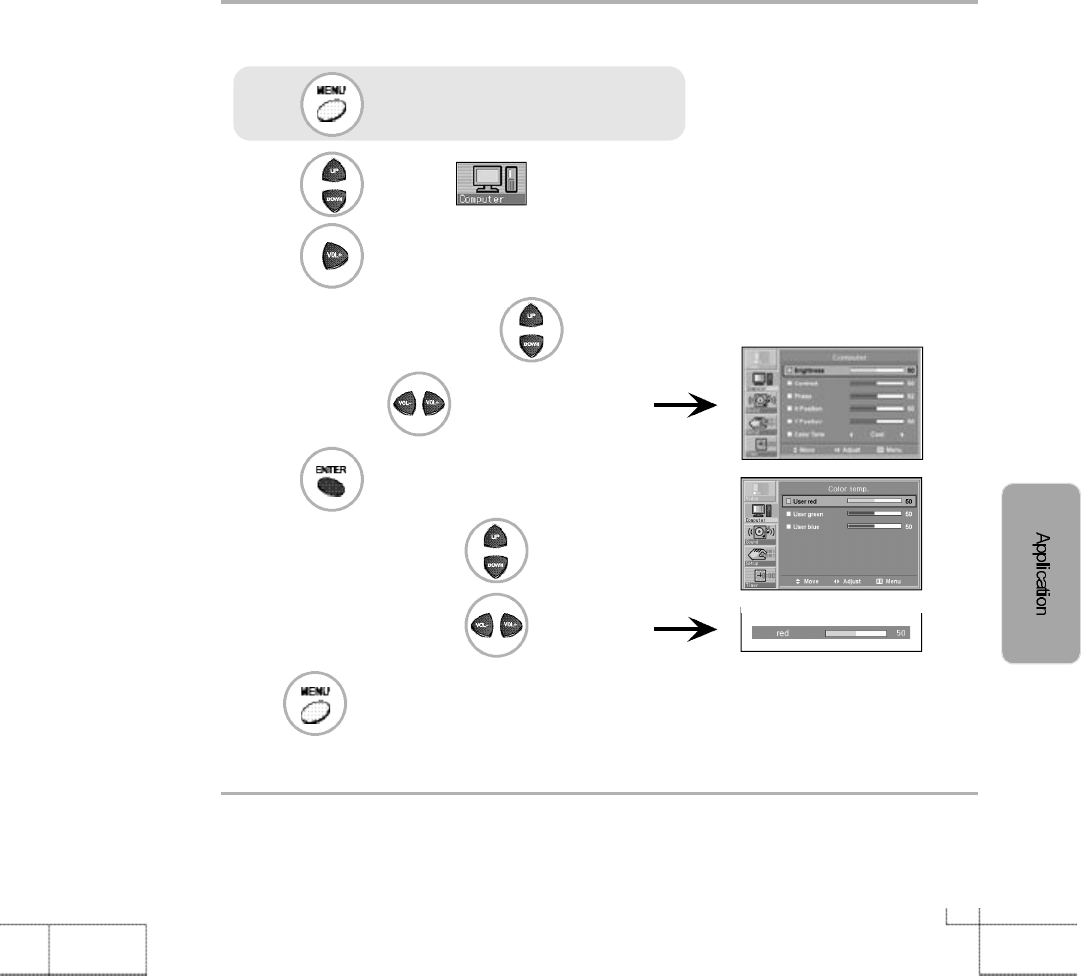
3 5
Color Tone (Manual adjustment)
1. Press to move to .
2. Press to get into a sub menu.
3. Select the item "Color Tone" with .
4. Select "User" with .
5. Press .
6. Select the item to adjust with .
7. Adjust the setting value with .
Press after making adjustments to return to the previous menu.
Press it again to leave the menu.
P r e s s .
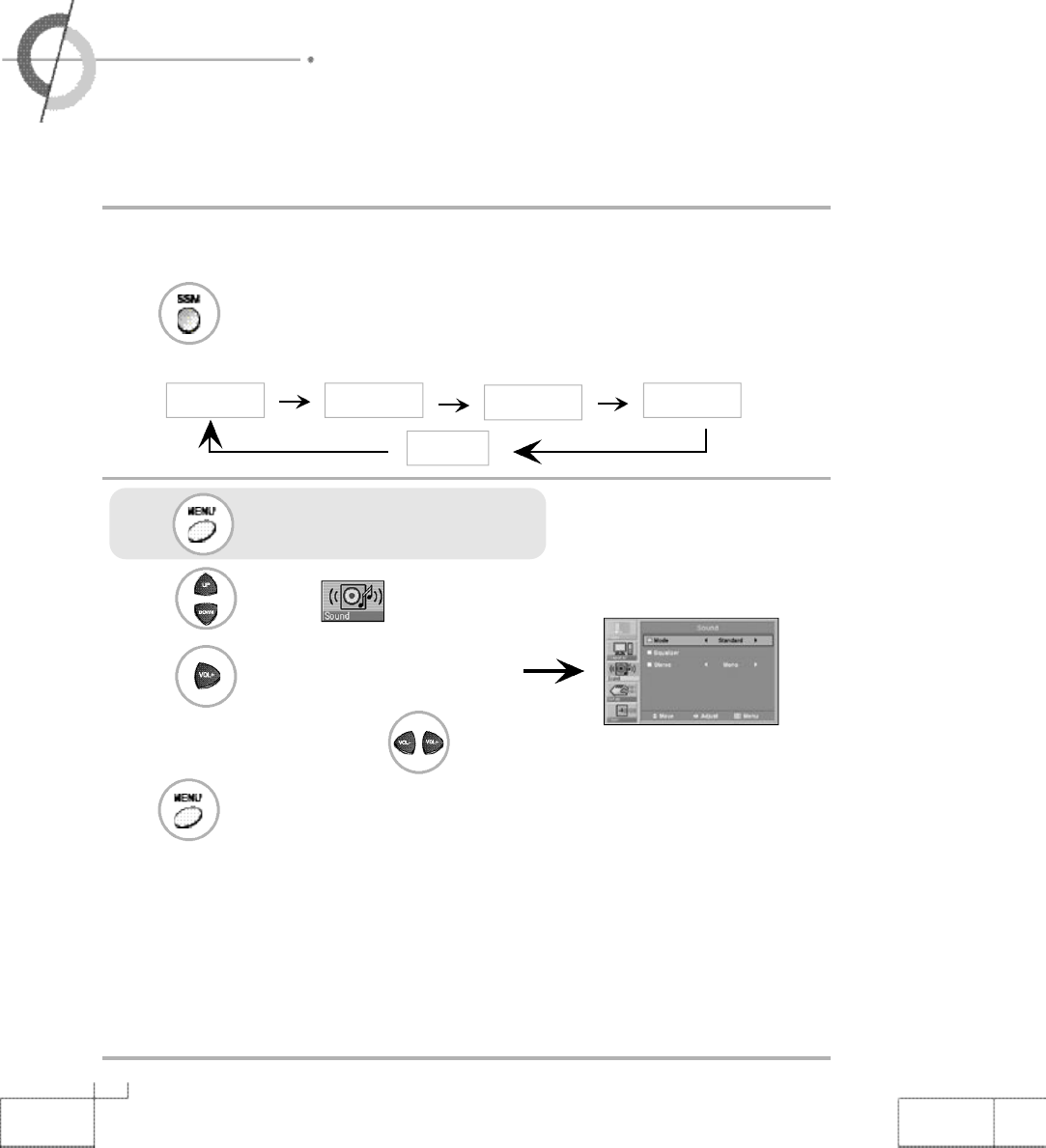
3 6
・
SSM (Sound Status Memory)
・
Equalizer
Modes
・Standard : It is the flat sound setting with no equalizer effect at all.
・Music : It is preset for music listening.
・
Movie : It is preset sound for watching a movie.
・Speech : It is preset for hearing vocal audio clearly.
・
User : Select when listening to the sound to user's preference.
(Please refer to page 37 Equalizer.)
1. Press to move to .
2. Press to get into sub menu.
3. Select one of the pre-set modes with .
Press after the selection to return to the previous menu.
Press it again to leave the menu.
Press .
SSM (Sound Status Memory)
Listening to the selected sound:
Press .
※
Select the pre-set sound mode by pressing the SSM button.
Standard Music Movie Speech
User
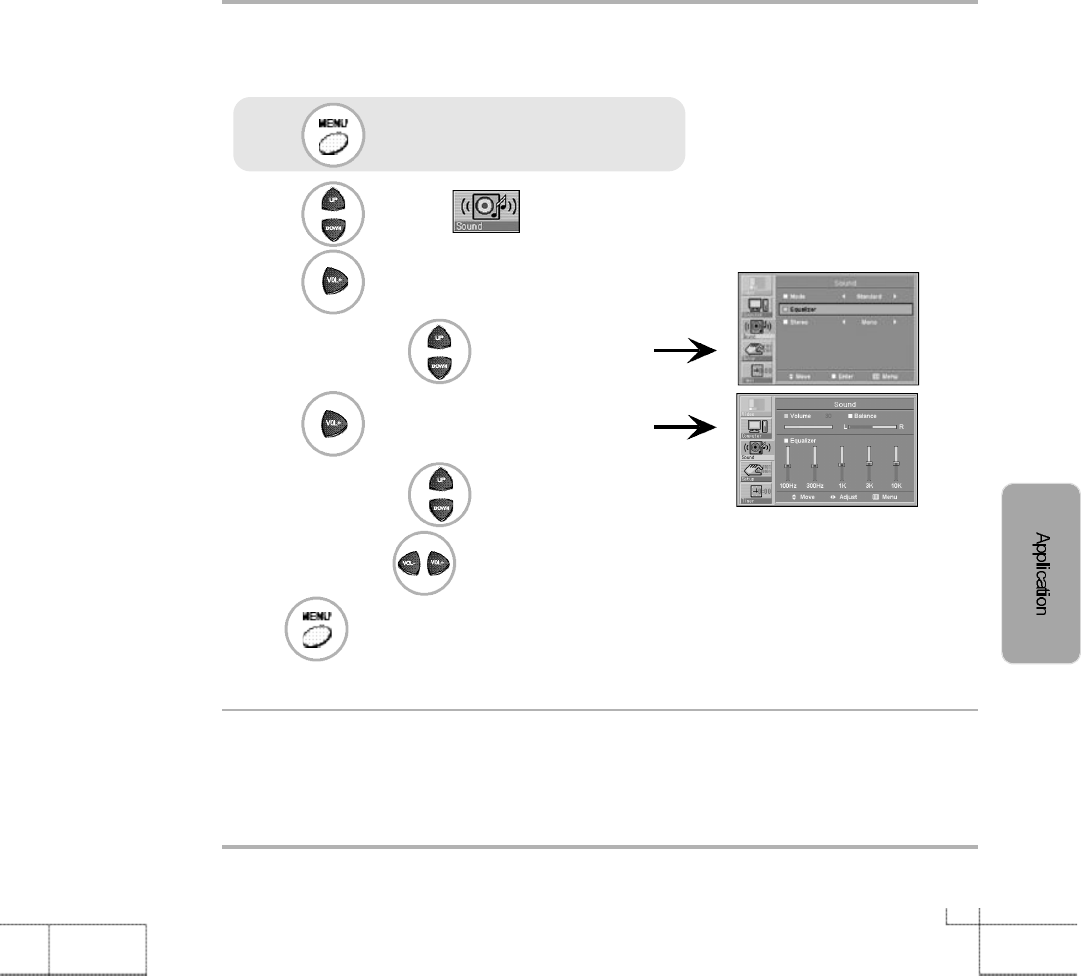
3 7
Equalizer
Adjustment is possible in any equalizer mode and will be stored in the user mode.
1. Press to move to .
2. Press to get into the sub menu.
3. Select equalizer with .
4. Press , then the equalizer menu pop up.
5. Select the menu with and adjust
the setting value with .
Press after making adjustments to return to the previous menu.
Press again to leave the menu.
User Mode
・Volume : It adjusts the sound volume.
・Balance : It adjusts the volume of speakers on the left and the right.
・Equalizer : It adjusts the volume by frequency bands and the user can select the desired sound quality.
Press .
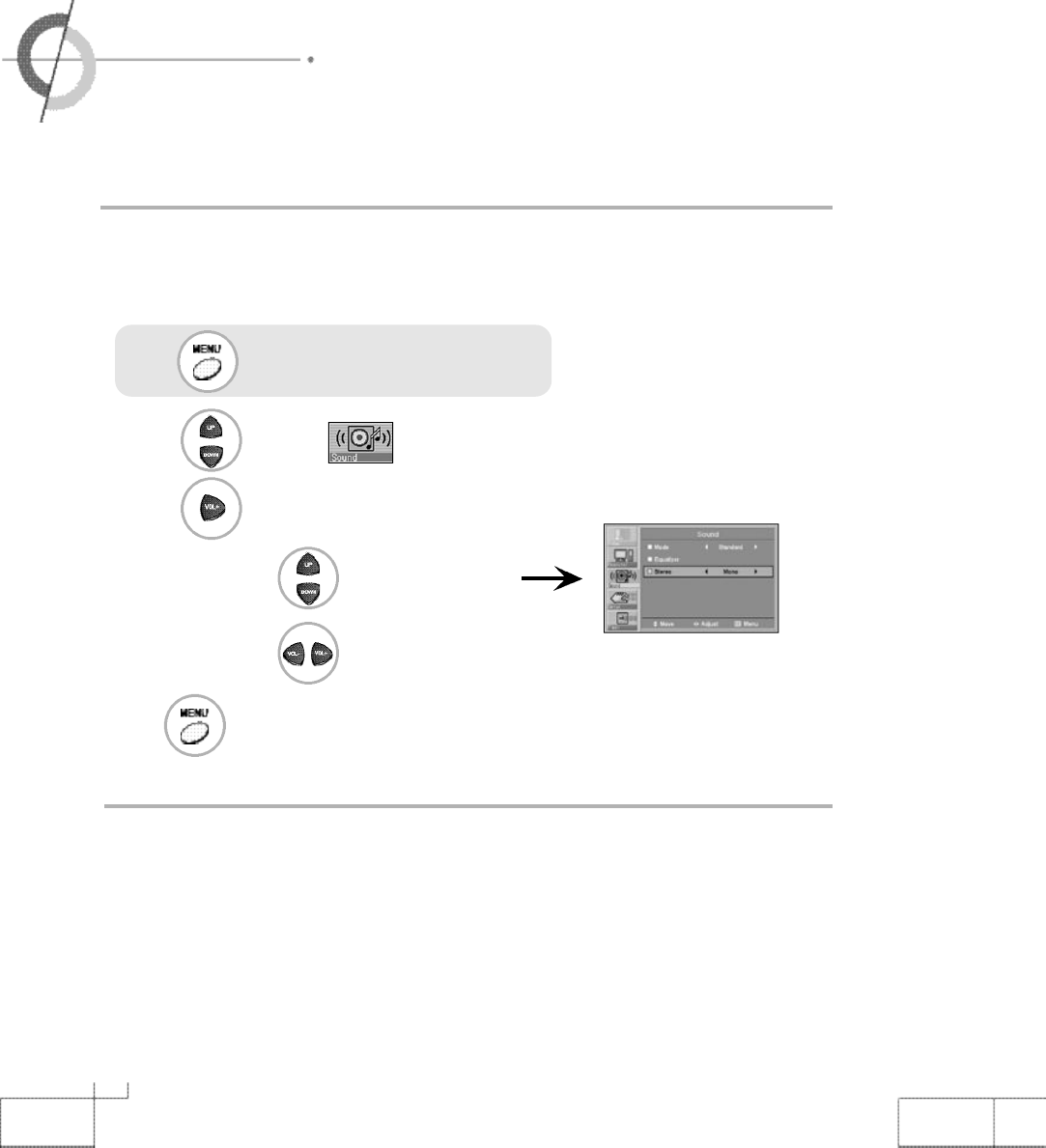
3 8
Press .
Stereo (How to set stereo)
If
TV signal reception is poor, the separation of stereo will be bad and noisy. In this occasion, set
the stereo to mono.
1. Press to move to .
2. Press to get into the sub menu.
3. Select "Stereo" with .
4. Select "Stereo" with .
Press after making adjustments to return to the previous menu.
Press it again to leave the menu.
・Stereo
・Reset
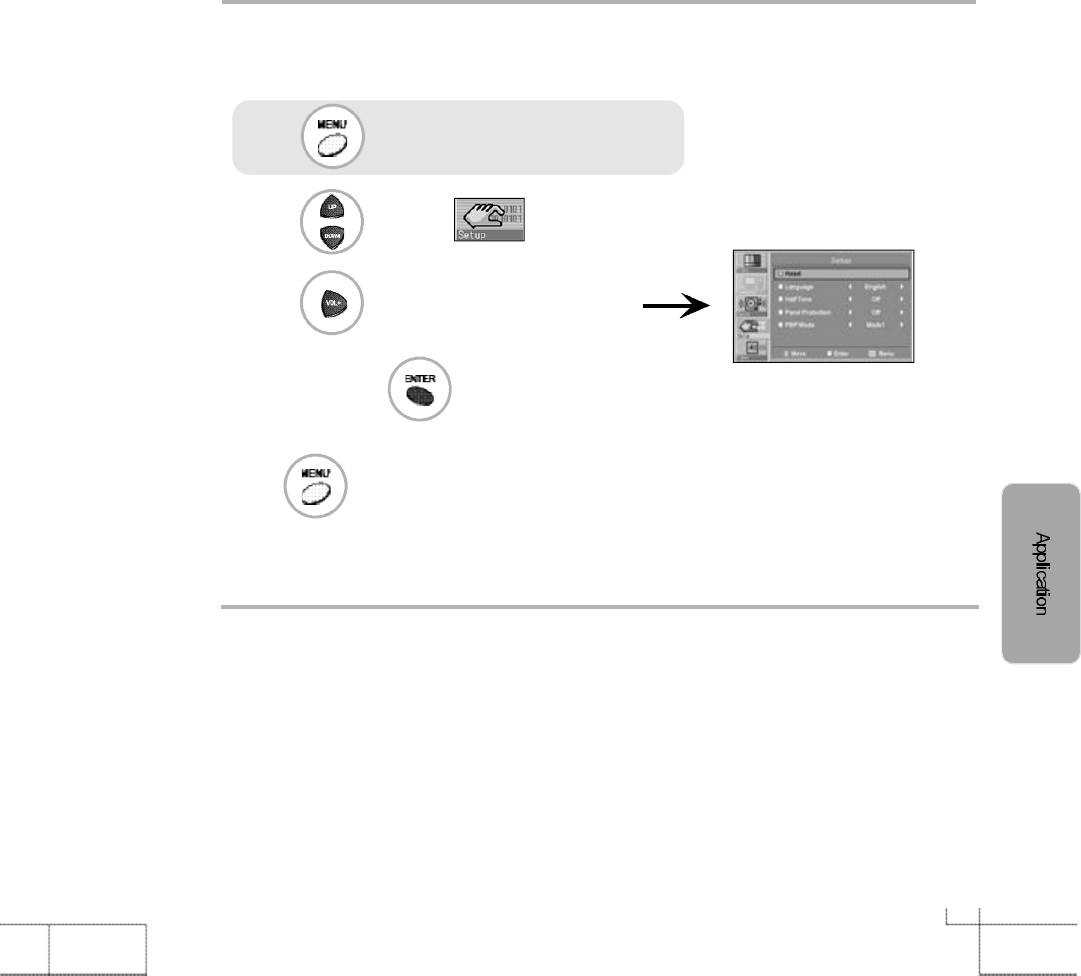
3 9
Press .
Reset (Factory default)
It resets all of the parameters to the factory default.
1. Press to move to .
2. Press to get into the sub menu.
3. Reset by pressing .
Press
after making adjustments to return to the previous menu.
※
The PDP will turn off then turn back on in few seconds. The parameters will be set to factory default.
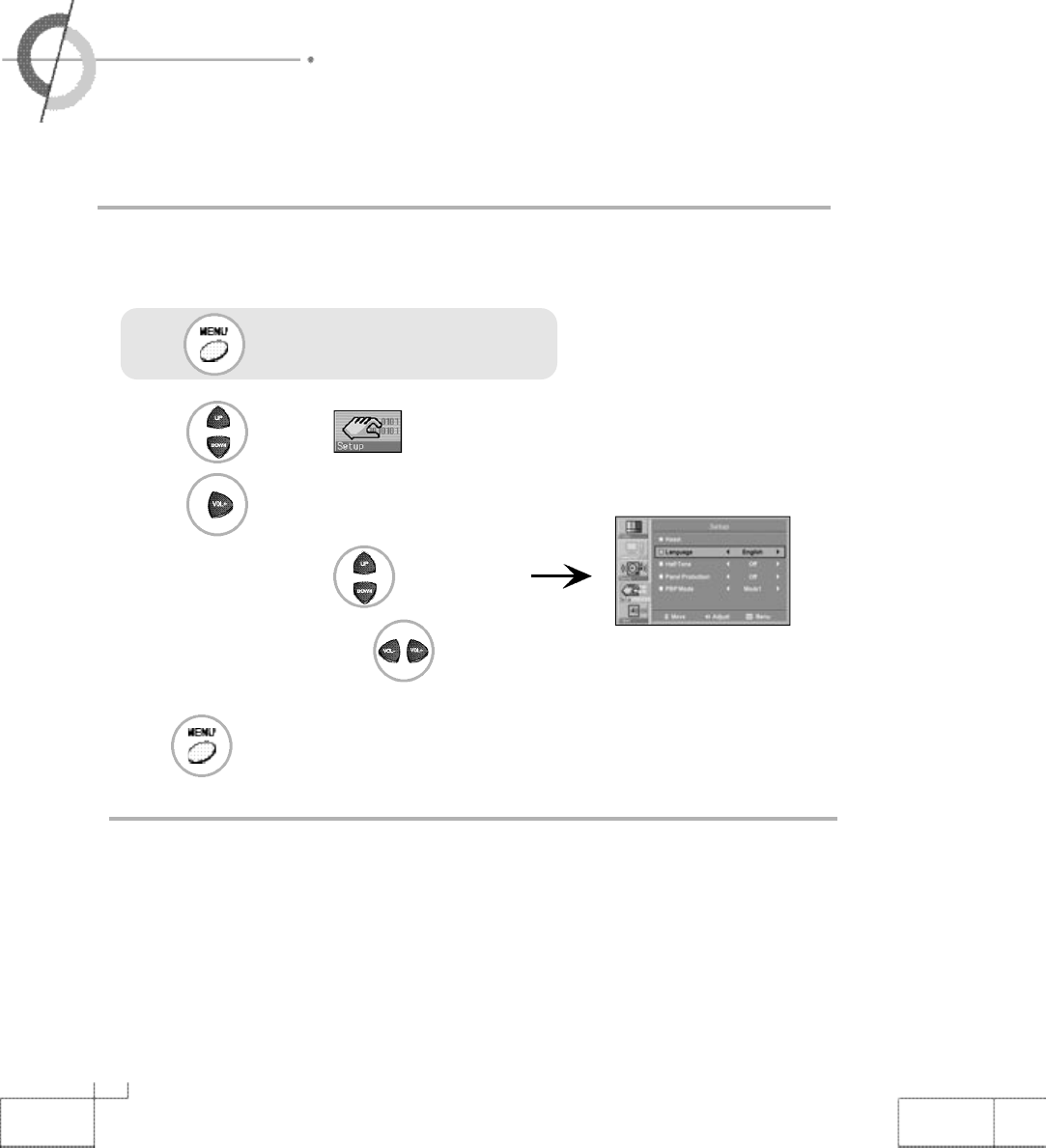
4 0
・Language
・Half Tone
Language
It adjusts the language of the OSD(On Screen Display) menu.
1. Press to move to .
2. Press to get into the sub menu.
3. Select the "Language" with
.
4. Select the desired language with .
Press after making adjustments to return to the previous menu.
Press it again to leave the menu.
Press .
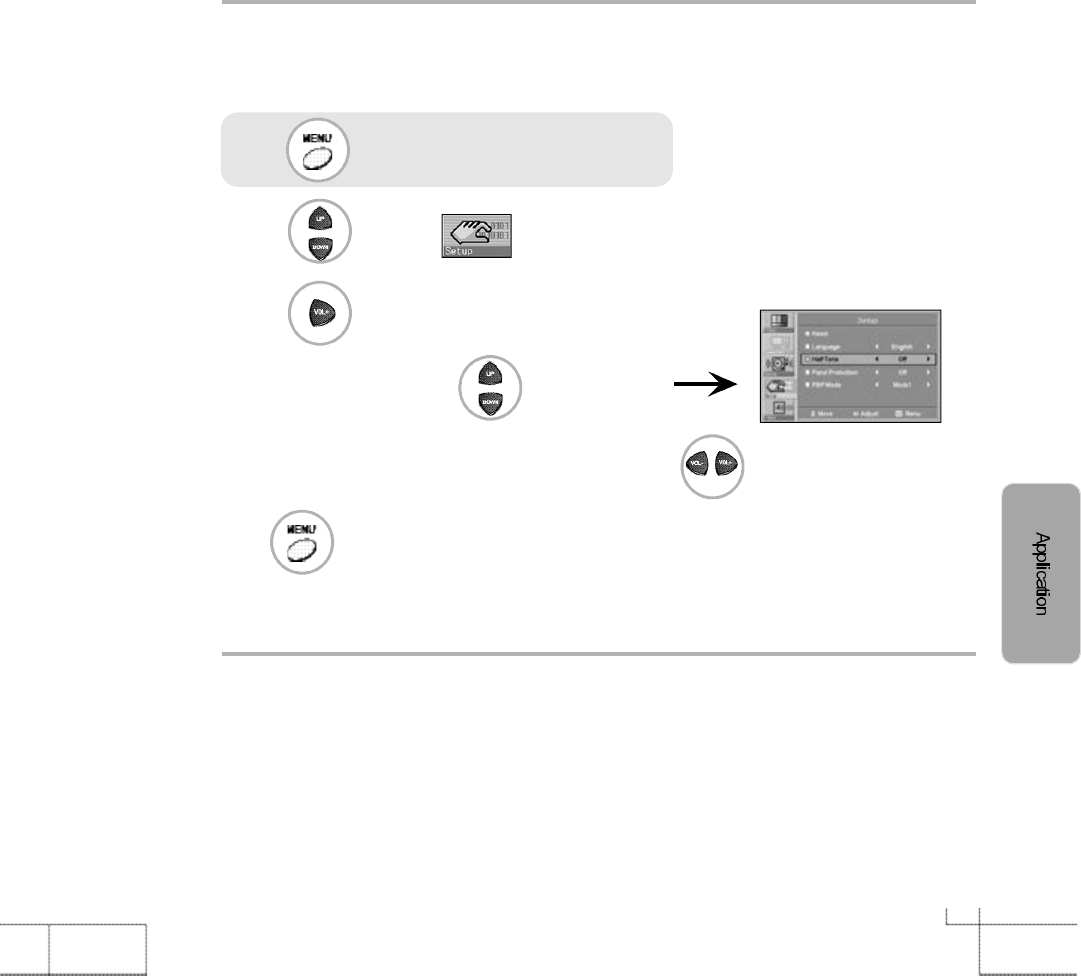
4 1
Press .
Half Tone
It changes the background color of the menu frame.
It can be set in a semitransparent or opaque manner.
1. Press to move to .
2. Press to get into the sub menu.
3. Select "Half Tone" menu with .
4. Select "On (Semitransparent)" or "Off (Opaque)" by pressing .
Press after making adjustments to return to the previous menu.
Press it again to leave the menu.
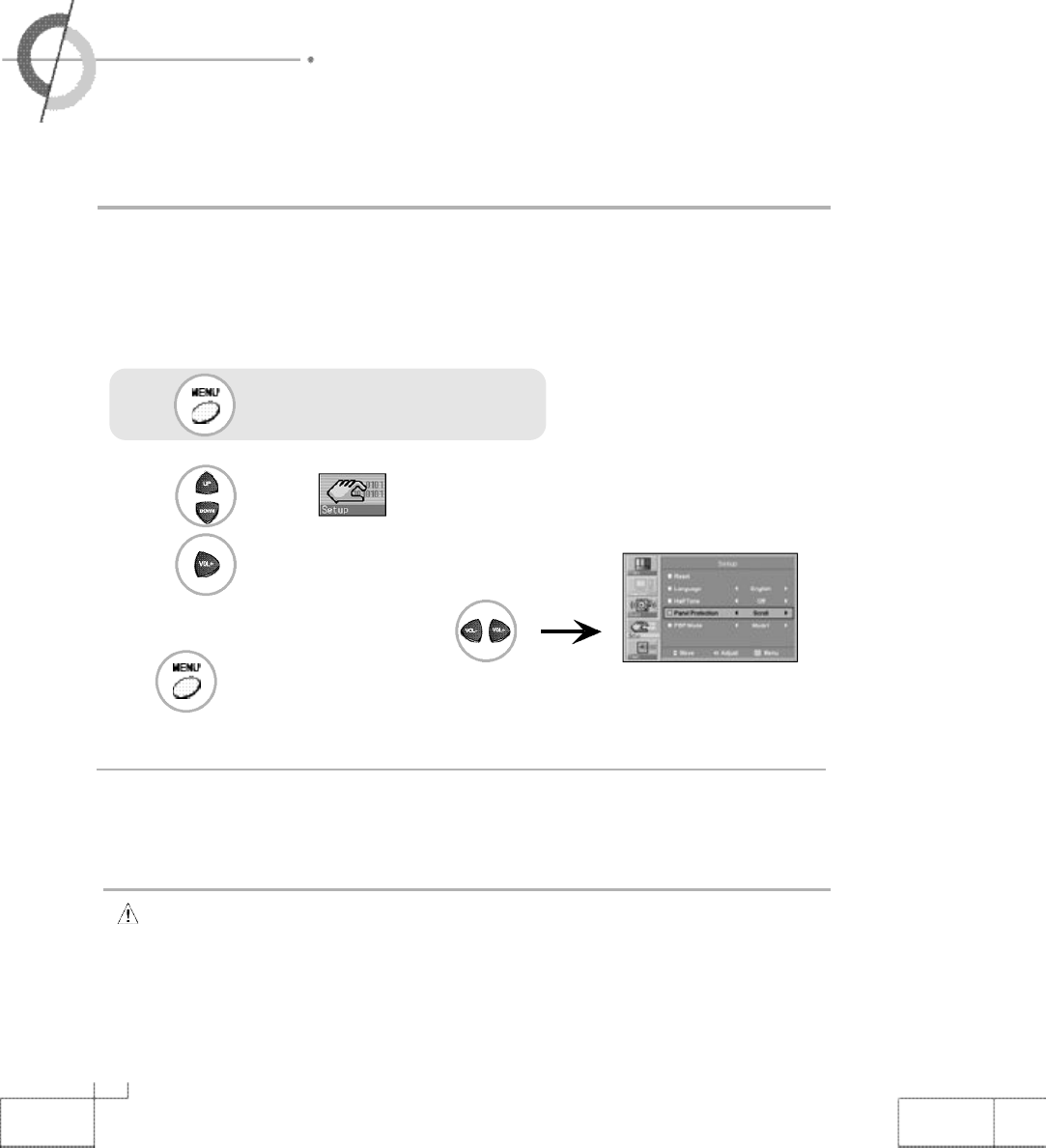
4 2
・Panel Protection
・PBP Mode
Panel Protection (How to set the panel protection function)
※
It is recommended that the panel protection mode be used on a paused/ frozon screen or on a screen
on which a company's logo remains for a logo period.
※
There is a possibility that screen flickers during changing panel protection mode. But, it is not a defect.
1. Press to move to .
2. Press to get into the sub menu.
3. Select the required panel protection mode with .
Press after making adjustments to return to the previous menu
.
Press it again to leave the menu.
・
Scroll : This is a function that scrolls a screen at 10 second intervals.
・
Bright Down : This is a function that lowers brightness of the screen for panel protection.
・All : Scroll and Birght Down mode are simultaneously operated.
・Off : Panel Protection mode is not operated.
Press .
CATION
-
This function does not fully prevent the image sticking that occurs when the fixed
screen continues for long, due to the feature of the panel.(Please refer to page 5)
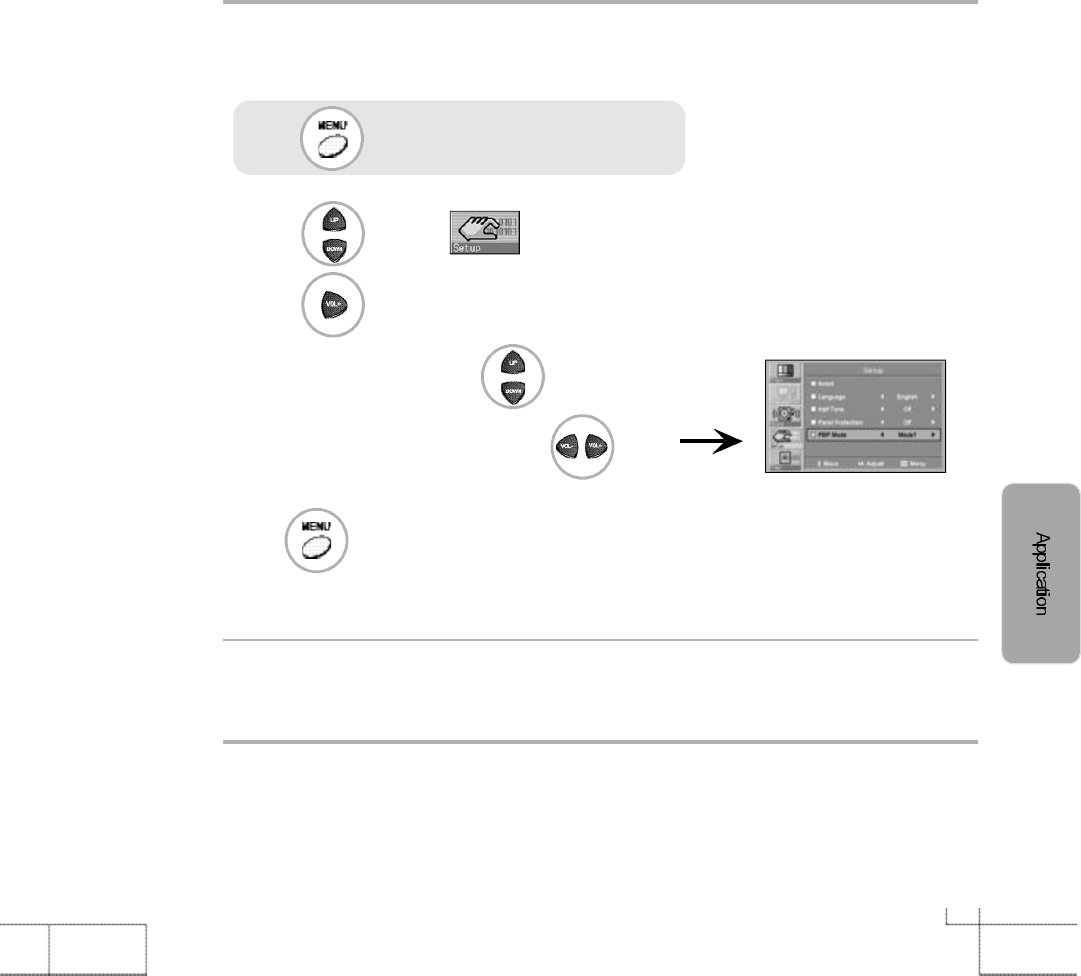
4 3
PBP Mode
・
It changes the ratio of the PBP screen from 16:9 to 4:3.
1. Press to move to
.
2. Press
to get into the sub menu.
3. Select "PBP Mode" menu with .
4. Select "Mode 1" or "Mode 2" by pressing .
Press after making adjustments to return to the previous menu.
Press it again to leave the menu.
PBP Modes
・Mode 1 : It makes 16:9 PBP ratio.
・Mode 2 : It makes 4:3 PBP ratio.
Press .
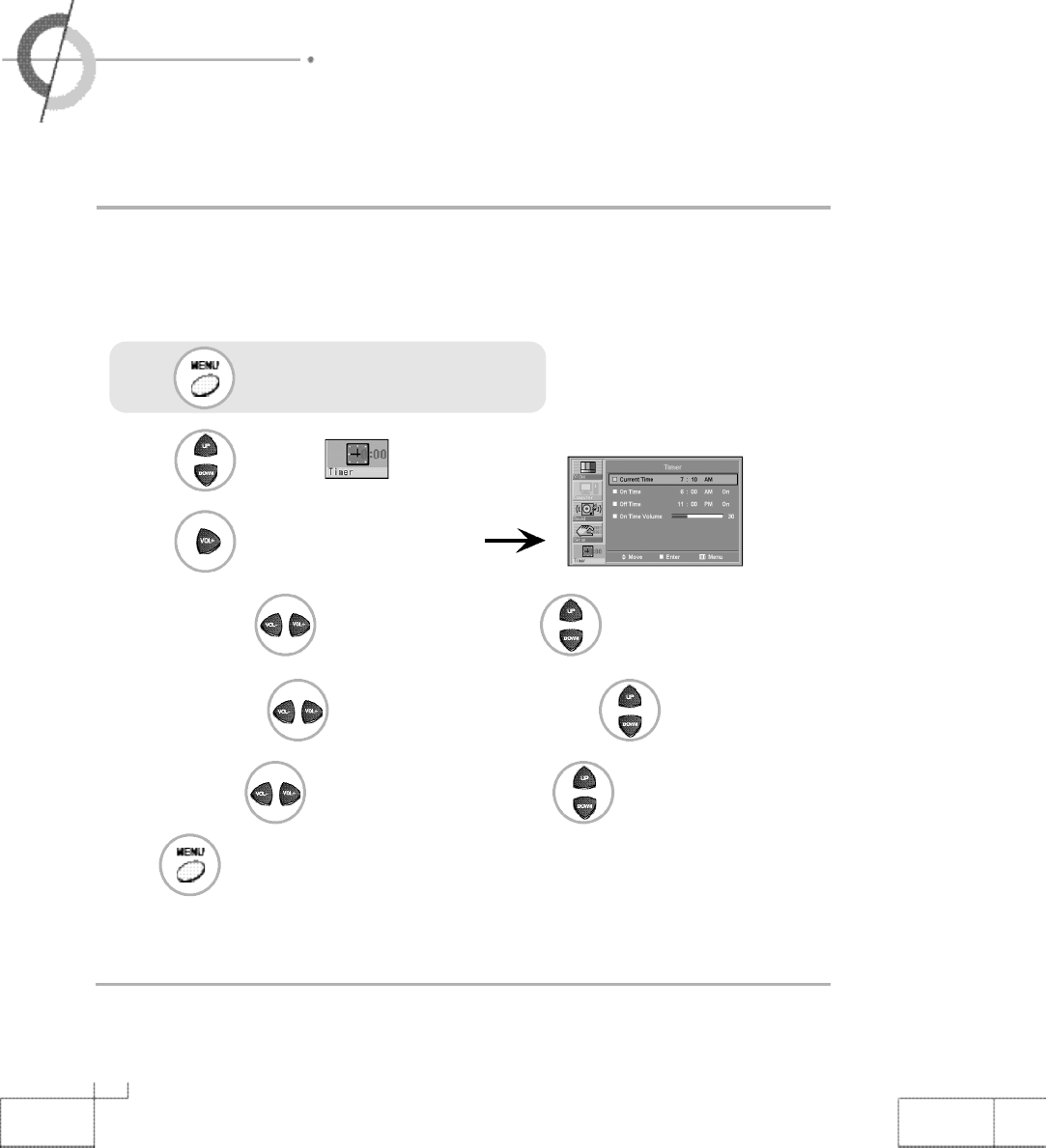
4 4
・Current Time setting
・On Time / Off Time (Time setting)
Current Time ( How to set the current time)
It sets the current time and then the automatic turn on/off can be set.
The time settings are retained only if the main power is on. If the Main power is off, the time
is reset. To retain the time setting, do not turn the main power switch off.
1. Press to move to .
2. Press to get into the sub menu.
Press .
Press after adjustment to return to the previous menu.
Press it again to leave the menu.
Move to "Hour" with
and adjust "Current Hour" with
.
Move to "Minute" with
and then adjust "Current Minute" with .
Move to "AM" with and then select "AM" or "PM" with .
Once "Current Time" is set, "On Time", "Off Time", "On time volume" settings are adjustable.
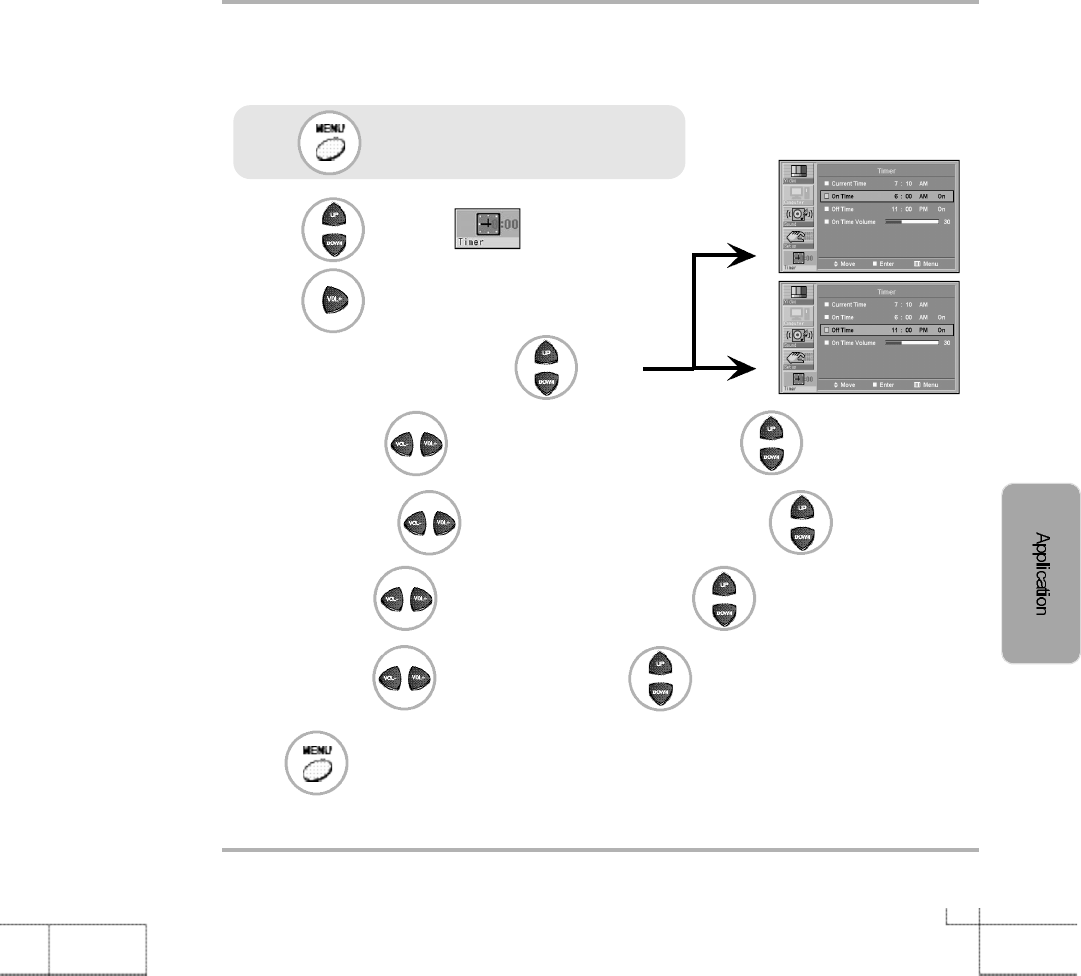
4 5
On Time / Off Time (Time setting)
Current Time must be set correctly for this function to work.
1. Press to move to .
2. Press to get into the sub menu.
3. Select "On Time" or "Off Time" with .
Press
after making adjustments to return to the previous menu.
Press it again to leave the menu.
Move to "Hour" with and then adjust the desired "Hour" with .
Move to "Minute" with
and then adjust the desired "Minute" with
.
Move to "Off" with and then select "On" with .
Press .
Move to "AM" with
and then select "AM" or "PM" with
.
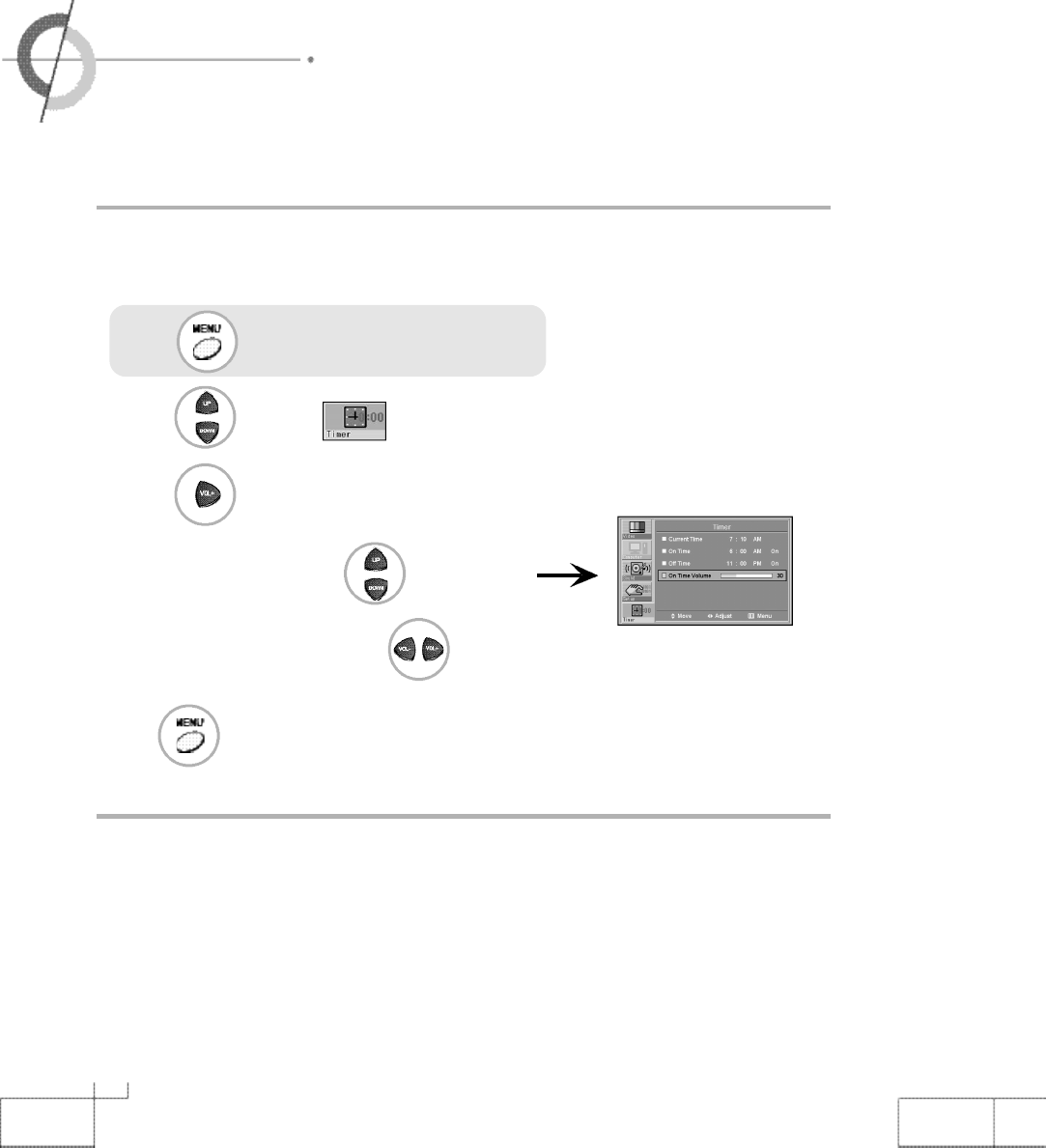
4 6
・On Time Volume
・Sleep Timer
On Time Volume (How to set the volume)
Current time must be set correctly for this function to work.
1. Press to move to .
2. Press to get into the sub menu.
3. Select "On Time Volume" with .
4. Adjust the desired volume value with
.
Press
after making adjustments to return to the previous menu.
Press it again to leave the menu.
Press .
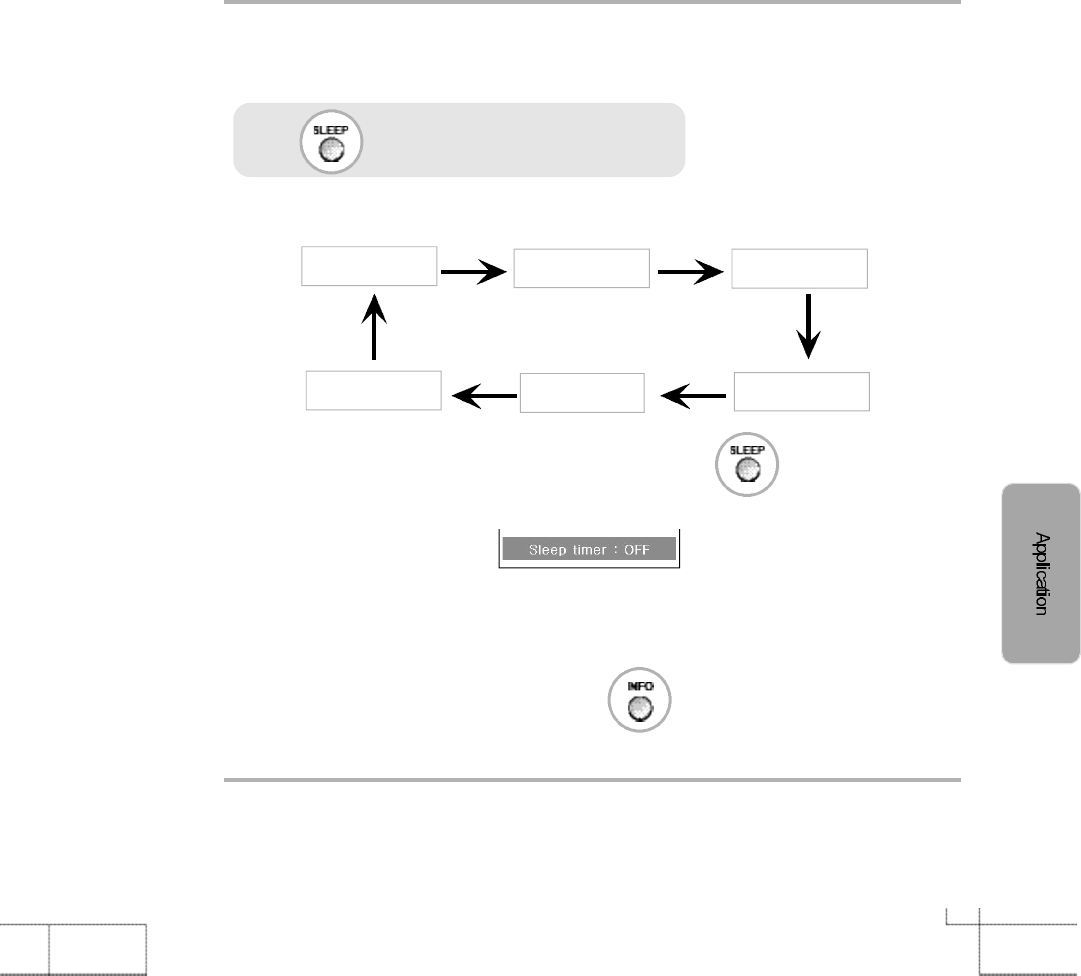
4 7
Sleep Timer
It sets time to make automatic turn off for the sleeping.
Press .
Sleep Timer: OFF Sleep Timer:
15 Minute
Sleep Timer:
120 Minute Sleep Timer:
90 Minute
Sleep Timer:
60 Minute
Sleep Timer:
30 Minute
The selection of the sleep timer will appear.
※
After the sleep timer appears on the screen for more than 20 seconds without pressing the
"Sleep" button, the appeared sleep timer is automatically set.
※
To check the current "Sleep timer" setting, press once.
※
Reset the sleep timer again, after the PDP power is turned off.
To disable the sleep timer set it to "Sleep Timer: OFF" by pressing .
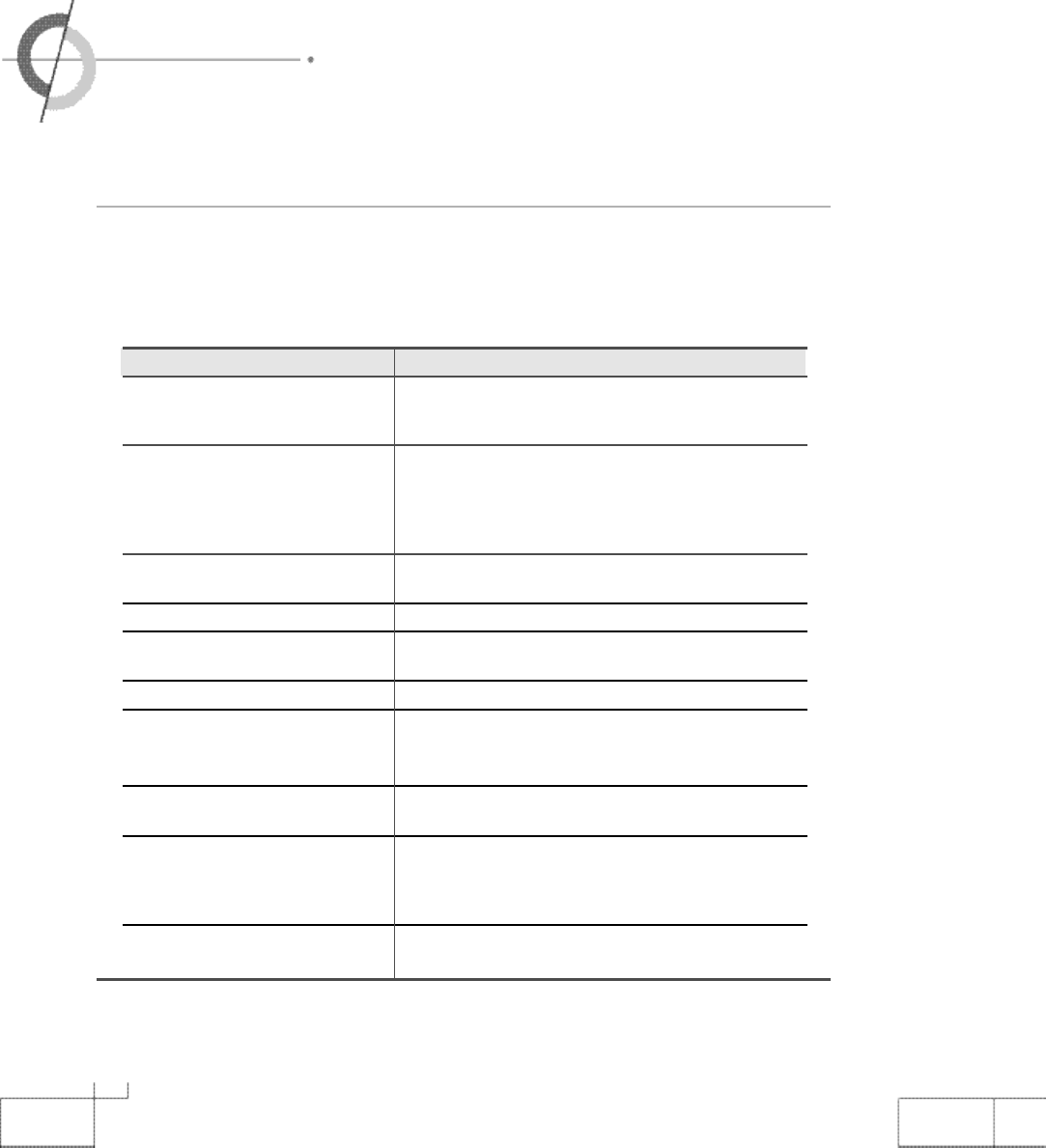
4 8
・T
rouble shooting
Problem Action
The screen does not appear. Is the power plug pulled out? Insert the power plug. Turn
the main power button on and press the power button of
the remote control.
The screen appears too
This problem occurs for a brief time in the process of
slowly after the power is turned on.
image elimination processing in order to hide temporary
screen noise that occurs when the power is turned on. But
if the screen does not come after 1 minute has passed,
contact your dealer or an authorized service center.
Screen is too bright or too dark. Perform brightness adjustment or Contrast adjustment.
(Please refer to page 33)
Screen is too large or too small.
Adjust the screen size. (Please refer to page 30)
Stripes appear on the screen
Stop using wireless telephones, hair driers and
and it shakes. electrical drills.
Screen appears in black and white. Adjust the screen in user mode. (Please refer to page 29)
Simultaneous Screen Check that PDP and external equipment are
does not appear. connected. Check the inputs of simultaneous screen by
pressing sub-screen selection.
The screen does not move. Press the STILL button. (Please refer to page 26) Check if
the Pause button is pressed on external equipment.
Computer Input Screen is abnormal.
Execute automatic adjustment by pressing AUTO ADJ but
-
ton. If the screen is still abnormal after automatic adjust-
ment, perform manual fine adjustment. Please refer to
page 32.
Automatic Turn On does not work. Automatic Turn On function works only when turning the
PDP monitor off with the remote control or Standby button.
In case a problem occurs with your PDP, please take the following steps first.
If you still have the problem, turn the power off and contact your dealer or an authorized
service center.
• Screen related Matters
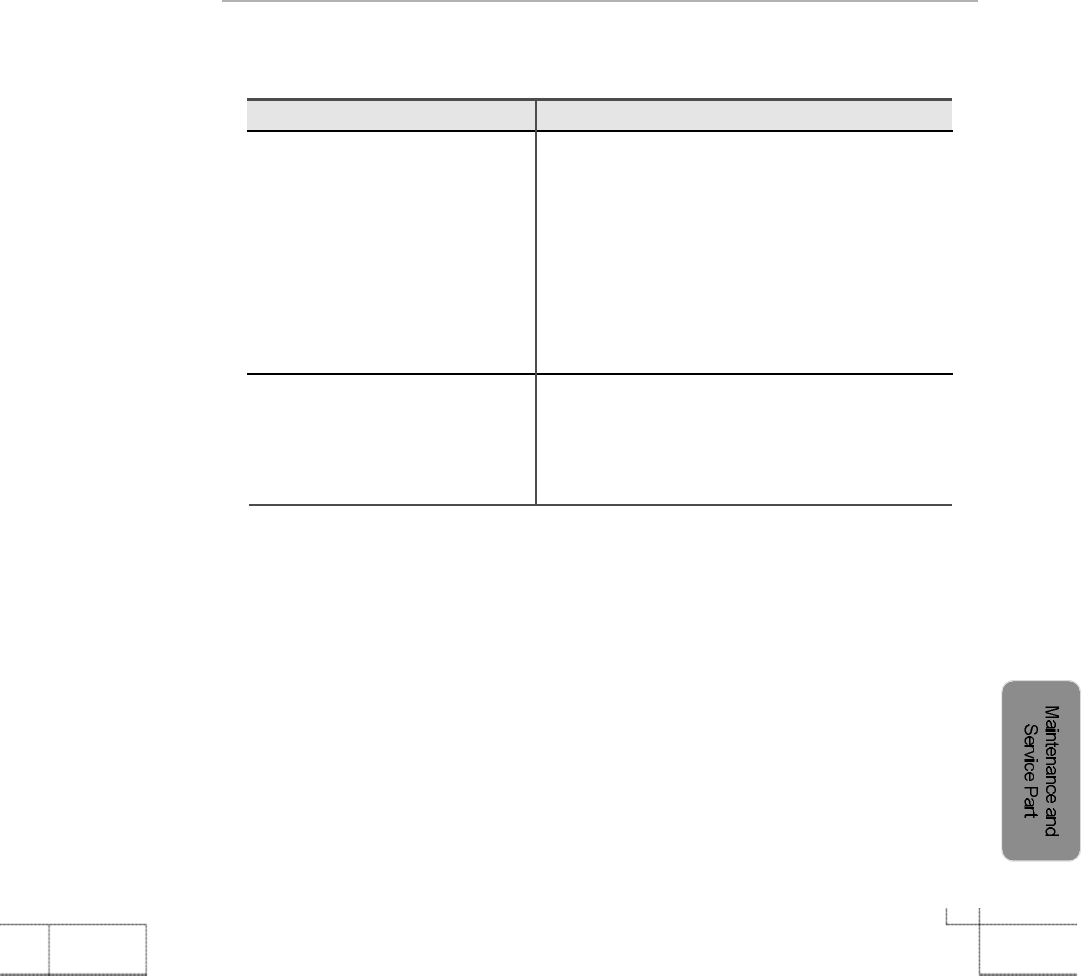
4 9
Problem Action
Screen appears, 1. Press the "Mute"button. (page 26)
2. Increase the sound by pressing volume adjustment
but there is no sound. button.
3. Check if voice terminal of external input is connected
properly.
4. Check if speaker cables are connected properly.
5. If it is on PIP mode, convert audio of main screen
and sub-screen by pressing S/SWAP.
6. Select and check the other input.
If the sound still does not work and the other channels
are the same after you have done as the above, contact
your dealer or an authorized service center.
Lots of noise (static) occurs.
When connecting a Set-Top-Box, check that it is on stereo
broadcasting. If it is, the TV channel may not be available or
the reception may be bad. Select "Mono" (Please refer to
page 39) Check the audio source with another player. If that
source is good, contact your dealer or an Authorized service
center.
• Sound related Matters
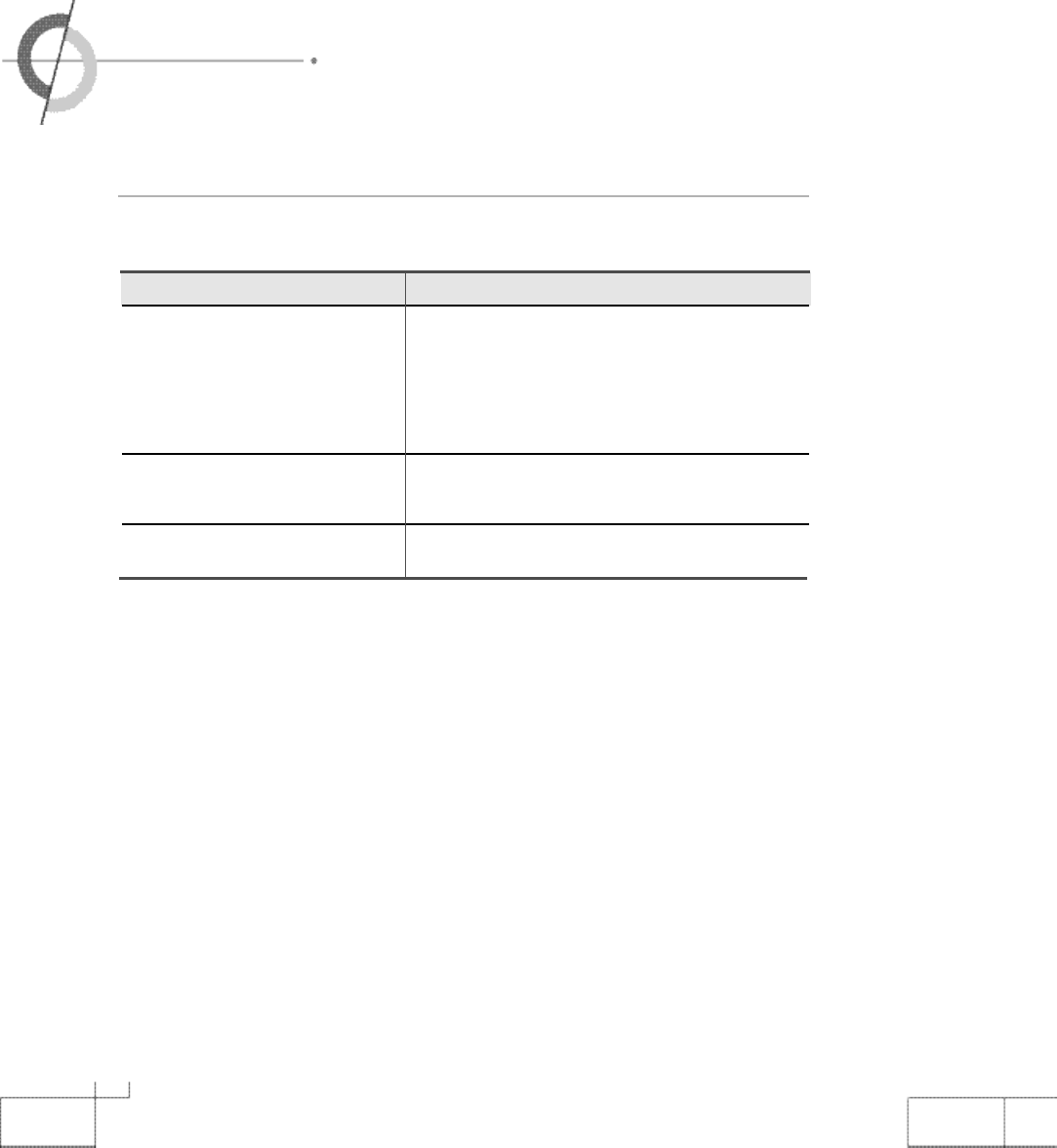
5 0
Problem Action
Remote control does not work. 1. Check if main power is On.
2. Check that the batteries of the remote control were
loaded properly.
3. Check to see if any obstacle exists between the PDP
and the remote control and remove it, if any.
4. If the batteries have no power, replace them with two
new batteries.
PDP makes strange noise It is the noise when the mechanism expands or con-
tracts from to changes to the environment due to factors
such as humidity, temperature, etc. It is not a failure.
PDP indication lamp is On.
The red means the Stand-by power is ON. It will take a
few seconds to turn off as the main power is off.
This PDP is for household use and registered as suitable on electromagnetic waves. Therefore,
you can use it in every location as well as residential areas.
• Others
・Trouble shooting
・Supporting display mode
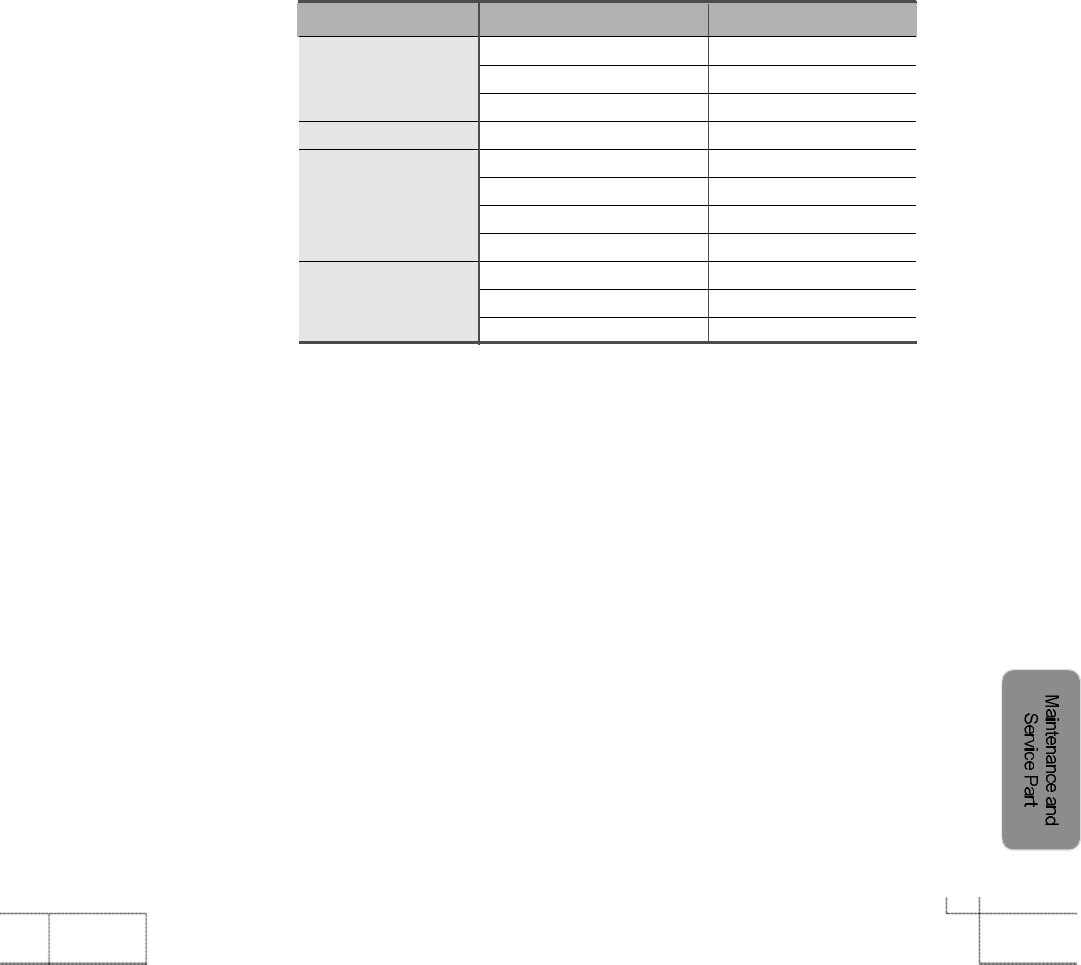
It is optimal screen when the resolution is 640 x 480.
5 1
If any signal of unsupported resolution is input, the "Out of Range" message appears.
Considerations in Installation
Supporting display mode
Resolution Horizontal Frequency (KHz) Vertical Frequency (Hz)
31.47 60
37.86 72
37.50 75
31.47 70
35.15 56
37.88 60
48.88 72
46.88 75
48.36 60
56.48 70
60.02 75
640×480
720
×
400
800×600
1024×768
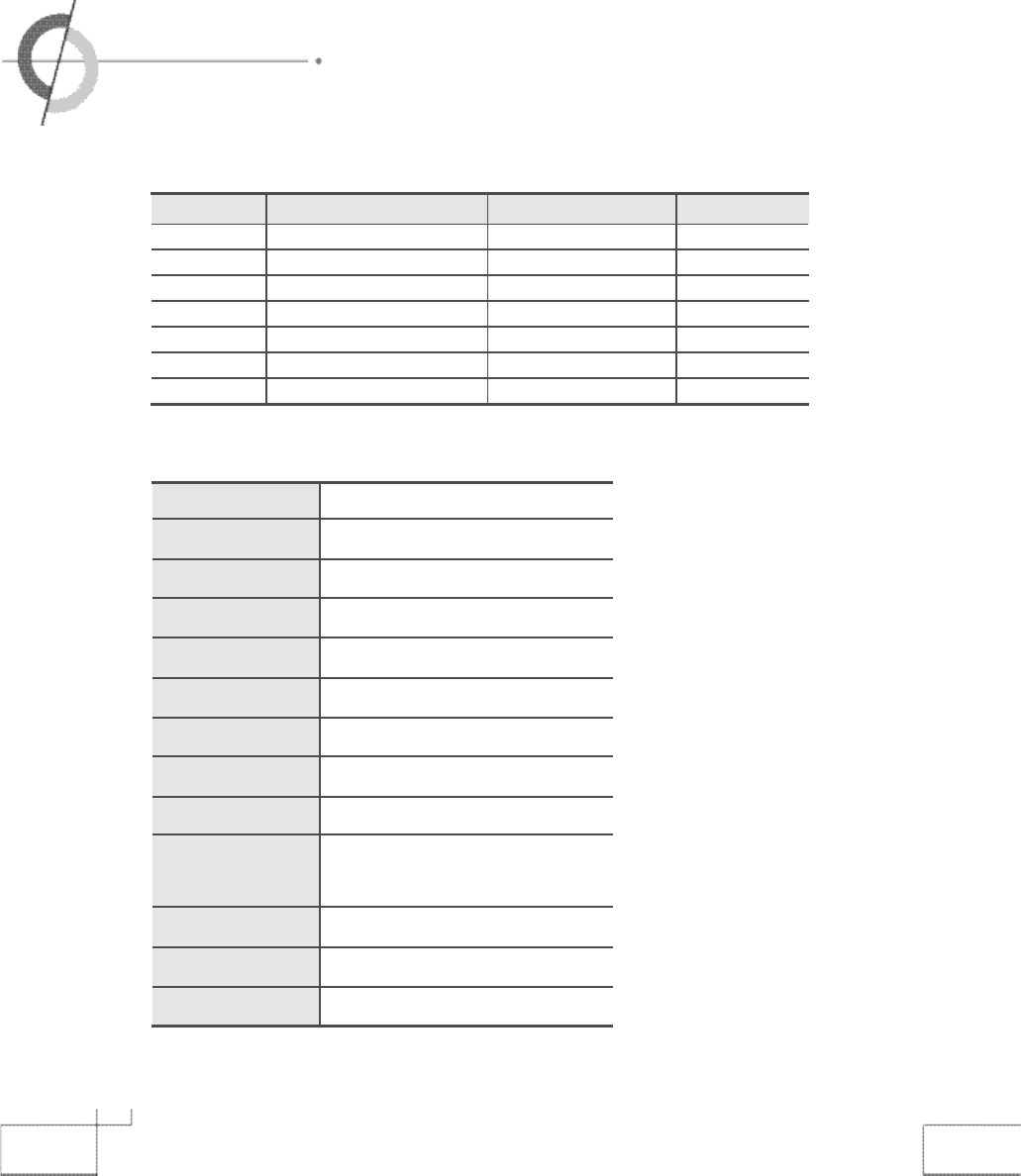
・
Specifications
Component Mode
[
Y
,
C
B
(
P
B
), C
R
( P
R
)]
Specifications
Resolution Horizontal Frequency (KHz) Vertical Frequency (Hz)
7 2 0×4 8 0 15.73 6 0 . 0 0 SDTV, DVD 480i
7 2 0×4 8 0 1 5 . 6 3 5 0 . 0 0 SDTV, DVD 480i
7 2 0×4 8 0 31.47 5 9 . 9 4 SDTV, 480p
1 2 8 0×7 2 0 45.00 6 0 . 0 0 HDTV, 720p
1 2 8 0×7 2 0 44.96 5 9 . 9 4 HDTV, 720p
1 9 2 0×1 0 8 0 33.75 6 0 . 0 0 HDTV, 1080i
1 9 2 0×1 0 8 0 33.72 5 9 . 9 4 HDTV, 1080i
Aspect Ratio 16 : 9
Screen Size (H×V) 920.1×518.4mm
Resolution 852×480(Wide VGA)
Cell pitch (H×V) 0.36(H)×1.08(V)mm
Displayable Colors 16.77M(256×256×256)
Brightness 1000cd/㎡(w/o filter)
Contrast 1200:1
Color Temperature 9500 。K
Viewing Angle 160 。
Input signal NTSC, PAL-M, PAL-N, PAL, SECAM,
SD, HD, VGA, SVGA, XGA
RGB Input DVI -Ⅰ(Analog/ Digital RGB)
AC Input AC100-240V~, 50/60Hz, 4A
Power Consumption 320W
If any signal of unsupported resolution is input, the "Out of Range" message appears.
5 2

・MEMO

・MEMO
・User information
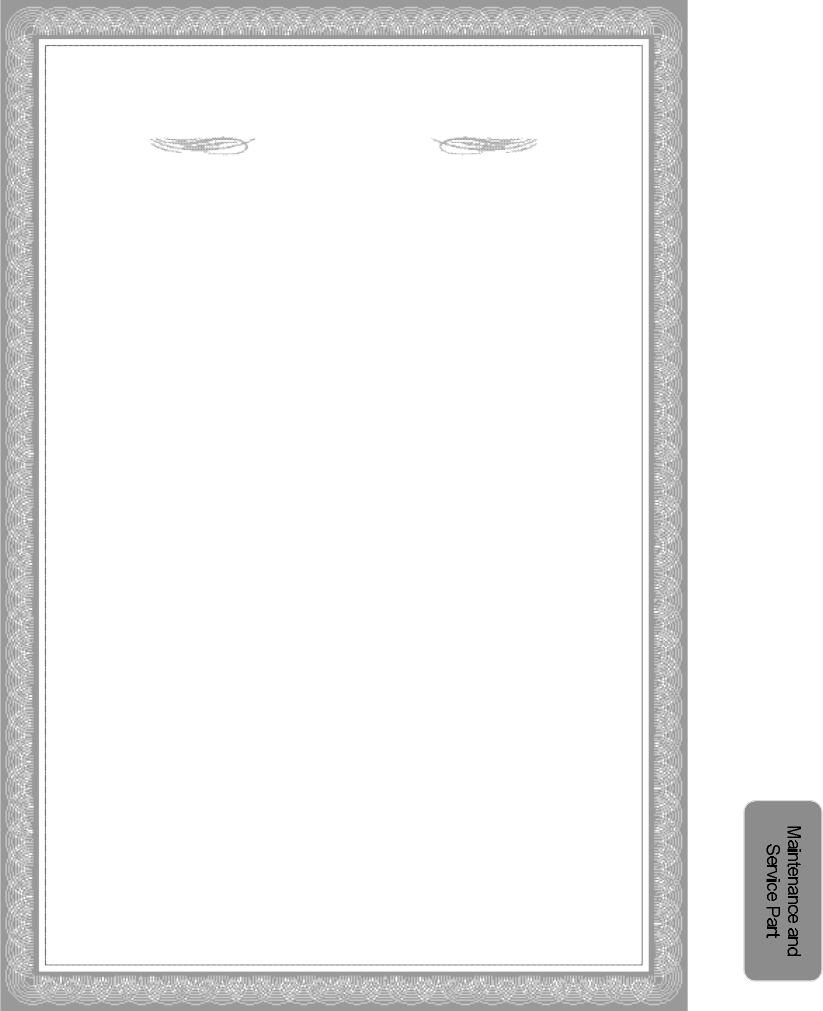
User information
Note: This equipment has been tested and found to comply with the
limit for a Class B digital device, pursuant to part 15 of the FCC
Rules. These limits are designed to prov
i
de reasonable protection
against harmful interference when the equipment is operated in a
commercial environment.
This equipment generates, uses and can radiate radio frequency
energy and, if not installed and used in accordance with the instruc
-
tion manual, may cause harmful interference to radio communica-
tions.
Operation of this equipment in a residential area is likely to cause
harmful interference in which case the user will be required to con-
nect the interference at his own expense.
Change or modification not expressly approved by the party respon
-
sible for compliance could void the user’s authority to operate the
equipment.
This is a class B product. In a domestic environment this product
may cause radio interference in which case the user may be
required to take adequate measures.